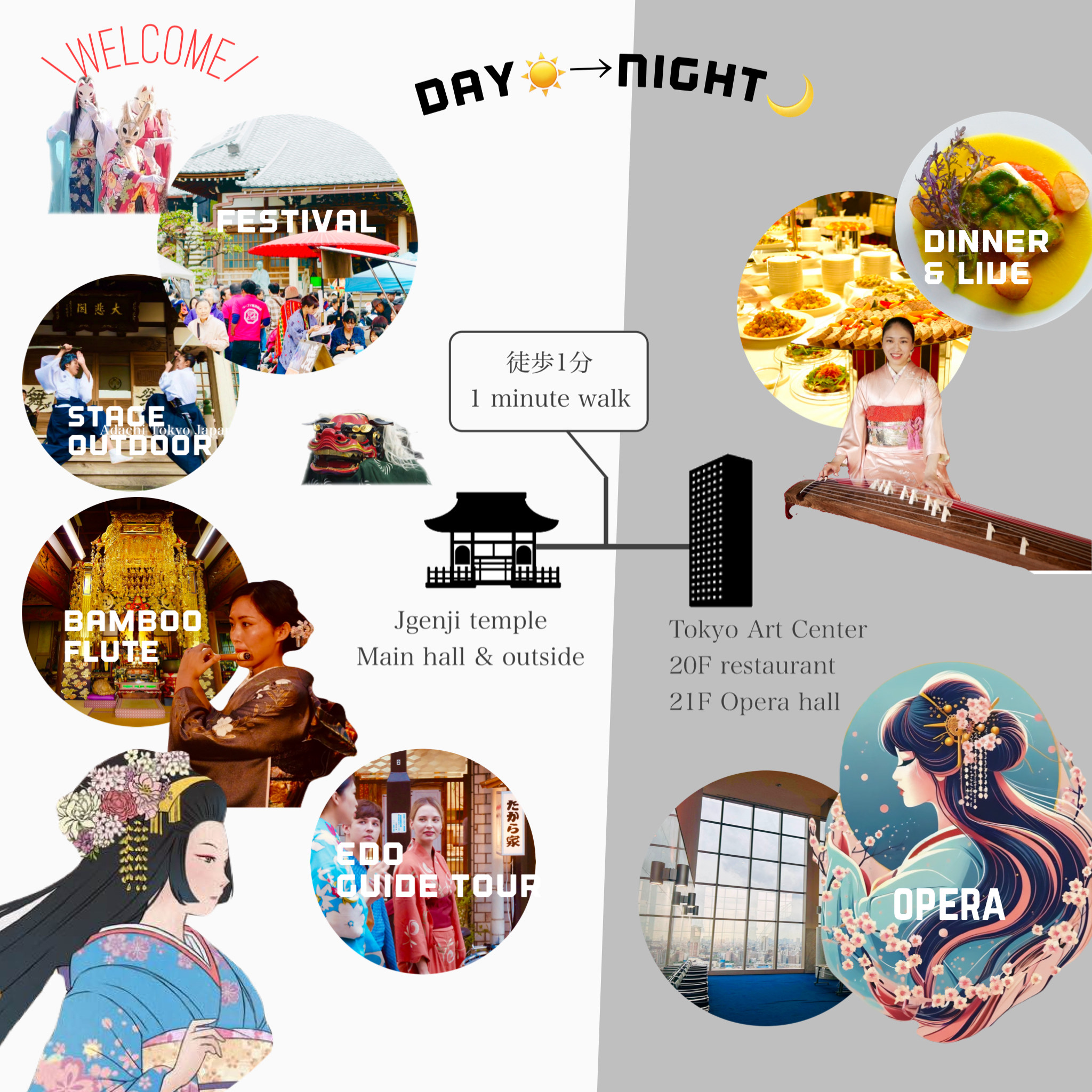
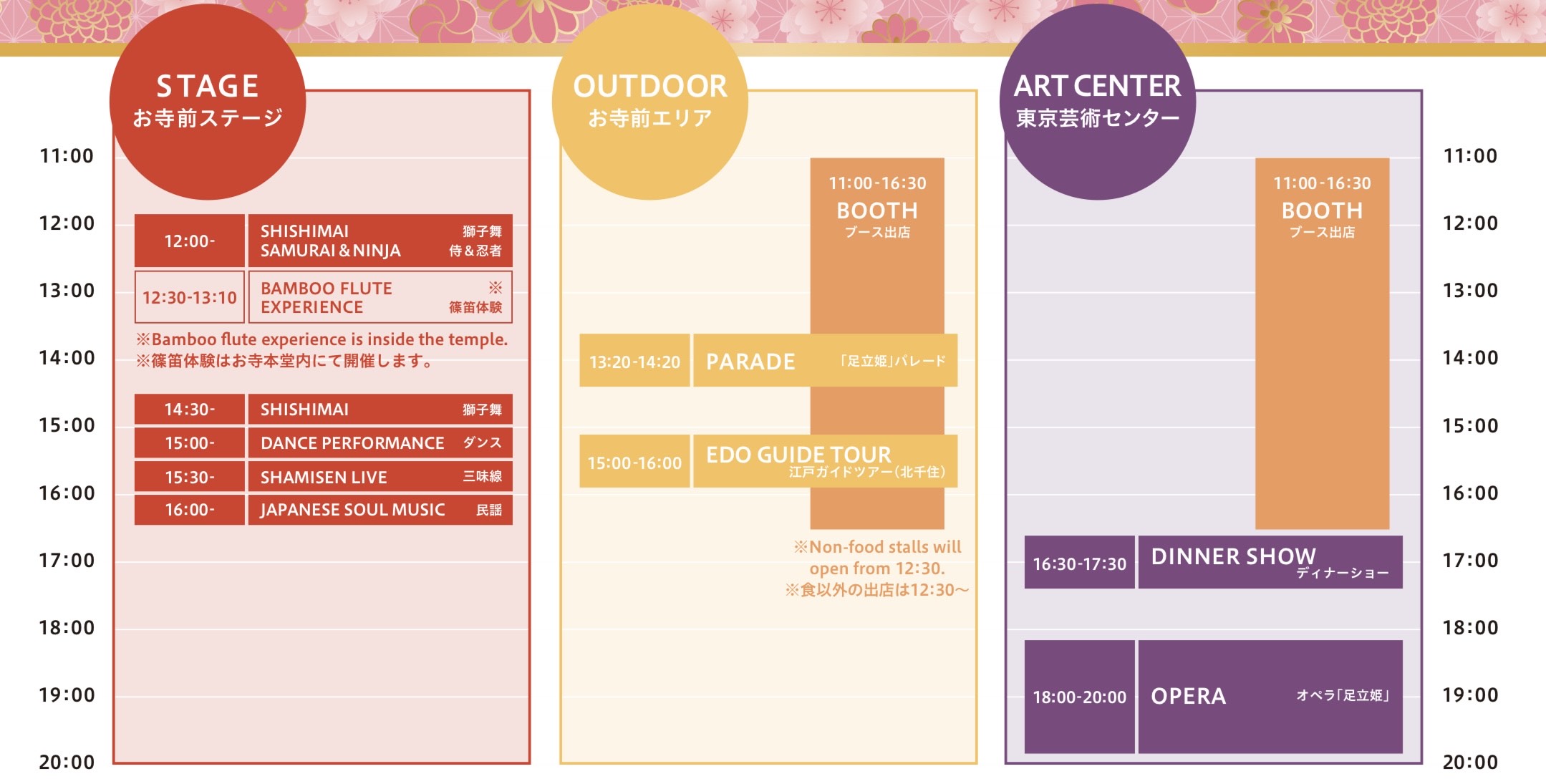
On December 18-19, 2024, the “Princess Adachi Festival” will take place in Kita-Senju, just a short distance from Asakusa and Ueno. This event, hosted by Rojicoya, an organization dedicated to promoting traditional Japanese culture, revives the 1,300-year-old legend of Princess Adachi, believed to bring happiness in the afterlife. It aims to share Japan’s rich cultural heritage with international visitors.
Topics
■JAPAN SOUL MUSIC(民謡の世界)
Japanese rhythm, Japanese music.
We will deliver Japan`s best shamisen and songs♪
・Folk song singer: Mitsuna Koyama
・Tsugaru shamisen player
Mayu Sugai (*19th only)
Shinobu Kawashima (*18th only)
Oyama Seiyu
日本のリズム、日本の音楽。
日本最高峰の三味線や唄をお届けします♪
・民謡歌手:小山みつな
・津軽三味線奏者
須貝麻由 (※19日のみ)
川嶋志乃舞(※18日のみ)
小山清雄
****************************************
On December 18-19, 2024, the “Princess Adachi Festival” will take place in Kita-Senju, just a short distance from Asakusa and Ueno. This event, revives the 1,300-year-old legend of Princess Adachi, believed to bring happiness in the afterlife. It aims to share Japan’s rich cultural heritage with international visitors.
Experience the magic of the Princess Adachi Festival in Tokyo! 🏮 Immerse yourself in traditional Japanese culture with lion dances, samurai experiences, Edo crafts, and more at this historic temple. Don`t miss the opera with English subtitles, koto performances, and a delicious buffet dinner. 🎎✨
Venue: Jigenji Temple (1-2-9 Senju, Adachi-ku, Tokyo) ,
Languages: The performance is in Japanese, with English subtitles available.
Organizer: @rojicoya
▼For more information on the Princess Adachi Festival: A Celebration of Wishes, please click here: https://rojicoya.jp/adachi-hime/
2024年12月18日から19日に、北千住で「プリンセス足立祭り」が開催されます!🏮✨
日本の伝統文化を広めるRojicoya主催のこのイベントは、1,300年前の足立姫伝説を蘇らせ、来世まで幸せをもたらすと信じられています。👘🎎世界中の方々と日本の豊かな文化遺産を共有する素晴らしい機会です!🎌🌟
会場:慈眼寺(東京都足立区千住1-2-9)北千住駅西口から徒歩約10分
主催 @rojicoya
▼「足立姫フェスティバル~願いを込めたお祭り~」の詳細については、こちらをご覧ください:https://rojicoya.jp/adachi-hime/
#足立姫 #伝統文化 #Rojicoya #文化遺産 #国際交流 #幸せをもたらす #日本の祭り #1300周年 #足立姫フェスティバル #東京 #千住宿400周年 #北千住 #足立区 #rojicoya
#PrincessAdachi #kitasenju #Tokyo #sightseeing #japanexperience #PrincessAdachiFestival #JapaneseCulture #TokyoEvents #TraditionalCrafts #OperaNight #EdoEmbroidery #LocalGourmetFood
#民謡 #野外ステージ #津軽三味線

■JAPAN SOUL MUSIC(民謡の世界)
Japanese rhythm, Japanese music.
We will deliver Japan`s best shamisen and songs♪
・Folk song singer: Mitsuna Koyama
・Tsugaru shamisen player
Mayu Sugai (*19th only)
Shinobu Kawashima (*18th only)
Oyama Seiyu
日本のリズム、日本の音楽。
日本最高峰の三味線や唄をお届けします♪
・民謡歌手:小山みつな
・津軽三味線奏者
須貝麻由 (※19日のみ)
川嶋志乃舞(※18日のみ)
小山清雄
****************************************
On December 18-19, 2024, the “Princess Adachi Festival” will take place in Kita-Senju, just a short distance from Asakusa and Ueno. This event, revives the 1,300-year-old legend of Princess Adachi, believed to bring happiness in the afterlife. It aims to share Japan’s rich cultural heritage with international visitors.
Experience the magic of the Princess Adachi Festival in Tokyo! 🏮 Immerse yourself in traditional Japanese culture with lion dances, samurai experiences, Edo crafts, and more at this historic temple. Don`t miss the opera with English subtitles, koto performances, and a delicious buffet dinner. 🎎✨
Venue: Jigenji Temple (1-2-9 Senju, Adachi-ku, Tokyo) ,
Languages: The performance is in Japanese, with English subtitles available.
Organizer: @rojicoya
▼For more information on the Princess Adachi Festival: A Celebration of Wishes, please click here: https://rojicoya.jp/adachi-hime/
2024年12月18日から19日に、北千住で「プリンセス足立祭り」が開催されます!🏮✨
日本の伝統文化を広めるRojicoya主催のこのイベントは、1,300年前の足立姫伝説を蘇らせ、来世まで幸せをもたらすと信じられています。👘🎎世界中の方々と日本の豊かな文化遺産を共有する素晴らしい機会です!🎌🌟
会場:慈眼寺(東京都足立区千住1-2-9)北千住駅西口から徒歩約10分
主催 @rojicoya
▼「足立姫フェスティバル~願いを込めたお祭り~」の詳細については、こちらをご覧ください:https://rojicoya.jp/adachi-hime/
#足立姫 #伝統文化 #Rojicoya #文化遺産 #国際交流 #幸せをもたらす #日本の祭り #1300周年 #足立姫フェスティバル #東京 #千住宿400周年 #北千住 #足立区 #rojicoya
#PrincessAdachi #kitasenju #Tokyo #sightseeing #japanexperience #PrincessAdachiFestival #JapaneseCulture #TokyoEvents #TraditionalCrafts #OperaNight #EdoEmbroidery #LocalGourmetFood
#民謡 #野外ステージ #津軽三味線
■JAPAN SOUL MUSIC(民謡の世界)
Japanese rhythm, Japanese music.
We will deliver Japan`s best shamisen and songs♪
・Folk song singer: Mitsuna Koyama
・Tsugaru shamisen player
Mayu Sugai (*19th only)
Shinobu Kawashima (*18th only)
Oyama Seiyu
日本のリズム、日本の音楽。
日本最高峰の三味線や唄をお届けします♪
・民謡歌手:小山みつな
・津軽三味線奏者
須貝麻由 (※19日のみ)
川嶋志乃舞(※18日のみ)
小山清雄
****************************************
On December 18-19, 2024, the “Princess Adachi Festival” will take place in Kita-Senju, just a short distance from Asakusa and Ueno. This event, revives the 1,300-year-old legend of Princess Adachi, believed to bring happiness in the afterlife. It aims to share Japan’s rich cultural heritage with international visitors.
Experience the magic of the Princess Adachi Festival in Tokyo! 🏮 Immerse yourself in traditional Japanese culture with lion dances, samurai experiences, Edo crafts, and more at this historic temple. Don`t miss the opera with English subtitles, koto performances, and a delicious buffet dinner. 🎎✨
Venue: Jigenji Temple (1-2-9 Senju, Adachi-ku, Tokyo) ,
Languages: The performance is in Japanese, with English subtitles available.
Organizer: @rojicoya
▼For more information on the Princess Adachi Festival: A Celebration of Wishes, please click here: https://rojicoya.jp/adachi-hime/
2024年12月18日から19日に、北千住で「プリンセス足立祭り」が開催されます!🏮✨
日本の伝統文化を広めるRojicoya主催のこのイベントは、1,300年前の足立姫伝説を蘇らせ、来世まで幸せをもたらすと信じられています。👘🎎世界中の方々と日本の豊かな文化遺産を共有する素晴らしい機会です!🎌🌟
会場:慈眼寺(東京都足立区千住1-2-9)北千住駅西口から徒歩約10分
主催 @rojicoya
▼「足立姫フェスティバル~願いを込めたお祭り~」の詳細については、こちらをご覧ください:https://rojicoya.jp/adachi-hime/
#足立姫 #伝統文化 #Rojicoya #文化遺産 #国際交流 #幸せをもたらす #日本の祭り #1300周年 #足立姫フェスティバル #東京 #千住宿400周年 #北千住 #足立区 #rojicoya
#PrincessAdachi #kitasenju #Tokyo #sightseeing #japanexperience #PrincessAdachiFestival #JapaneseCulture #TokyoEvents #TraditionalCrafts #OperaNight #EdoEmbroidery #LocalGourmetFood
#民謡 #野外ステージ #津軽三味線

■JAPAN SOUL MUSIC(民謡の世界)
Japanese rhythm, Japanese music.
We will deliver Japan`s best shamisen and songs♪
・Folk song singer: Mitsuna Koyama
・Tsugaru shamisen player
Mayu Sugai (*19th only)
Shinobu Kawashima (*18th only)
Oyama Seiyu
日本のリズム、日本の音楽。
日本最高峰の三味線や唄をお届けします♪
・民謡歌手:小山みつな
・津軽三味線奏者
須貝麻由 (※19日のみ)
川嶋志乃舞(※18日のみ)
小山清雄
****************************************
On December 18-19, 2024, the “Princess Adachi Festival” will take place in Kita-Senju, just a short distance from Asakusa and Ueno. This event, revives the 1,300-year-old legend of Princess Adachi, believed to bring happiness in the afterlife. It aims to share Japan’s rich cultural heritage with international visitors.
Experience the magic of the Princess Adachi Festival in Tokyo! 🏮 Immerse yourself in traditional Japanese culture with lion dances, samurai experiences, Edo crafts, and more at this historic temple. Don`t miss the opera with English subtitles, koto performances, and a delicious buffet dinner. 🎎✨
Venue: Jigenji Temple (1-2-9 Senju, Adachi-ku, Tokyo) ,
Languages: The performance is in Japanese, with English subtitles available.
Organizer: @rojicoya
▼For more information on the Princess Adachi Festival: A Celebration of Wishes, please click here: https://rojicoya.jp/adachi-hime/
2024年12月18日から19日に、北千住で「プリンセス足立祭り」が開催されます!🏮✨
日本の伝統文化を広めるRojicoya主催のこのイベントは、1,300年前の足立姫伝説を蘇らせ、来世まで幸せをもたらすと信じられています。👘🎎世界中の方々と日本の豊かな文化遺産を共有する素晴らしい機会です!🎌🌟
会場:慈眼寺(東京都足立区千住1-2-9)北千住駅西口から徒歩約10分
主催 @rojicoya
▼「足立姫フェスティバル~願いを込めたお祭り~」の詳細については、こちらをご覧ください:https://rojicoya.jp/adachi-hime/
#足立姫 #伝統文化 #Rojicoya #文化遺産 #国際交流 #幸せをもたらす #日本の祭り #1300周年 #足立姫フェスティバル #東京 #千住宿400周年 #北千住 #足立区 #rojicoya
#PrincessAdachi #kitasenju #Tokyo #sightseeing #japanexperience #PrincessAdachiFestival #JapaneseCulture #TokyoEvents #TraditionalCrafts #OperaNight #EdoEmbroidery #LocalGourmetFood
#民謡 #野外ステージ #津軽三味線
■JAPAN SOUL MUSIC(民謡の世界)
Japanese rhythm, Japanese music.
We will deliver Japan`s best shamisen and songs♪
・Folk song singer: Mitsuna Koyama
・Tsugaru shamisen player
Mayu Sugai (*19th only)
Shinobu Kawashima (*18th only)
Oyama Seiyu
日本のリズム、日本の音楽。
日本最高峰の三味線や唄をお届けします♪
・民謡歌手:小山みつな
・津軽三味線奏者
須貝麻由 (※19日のみ)
川嶋志乃舞(※18日のみ)
小山清雄
****************************************
On December 18-19, 2024, the “Princess Adachi Festival” will take place in Kita-Senju, just a short distance from Asakusa and Ueno. This event, revives the 1,300-year-old legend of Princess Adachi, believed to bring happiness in the afterlife. It aims to share Japan’s rich cultural heritage with international visitors.
Experience the magic of the Princess Adachi Festival in Tokyo! 🏮 Immerse yourself in traditional Japanese culture with lion dances, samurai experiences, Edo crafts, and more at this historic temple. Don`t miss the opera with English subtitles, koto performances, and a delicious buffet dinner. 🎎✨
Venue: Jigenji Temple (1-2-9 Senju, Adachi-ku, Tokyo) ,
Languages: The performance is in Japanese, with English subtitles available.
Organizer: @rojicoya
▼For more information on the Princess Adachi Festival: A Celebration of Wishes, please click here: https://rojicoya.jp/adachi-hime/
2024年12月18日から19日に、北千住で「プリンセス足立祭り」が開催されます!🏮✨
日本の伝統文化を広めるRojicoya主催のこのイベントは、1,300年前の足立姫伝説を蘇らせ、来世まで幸せをもたらすと信じられています。👘🎎世界中の方々と日本の豊かな文化遺産を共有する素晴らしい機会です!🎌🌟
会場:慈眼寺(東京都足立区千住1-2-9)北千住駅西口から徒歩約10分
主催 @rojicoya
▼「足立姫フェスティバル~願いを込めたお祭り~」の詳細については、こちらをご覧ください:https://rojicoya.jp/adachi-hime/
#足立姫 #伝統文化 #Rojicoya #文化遺産 #国際交流 #幸せをもたらす #日本の祭り #1300周年 #足立姫フェスティバル #東京 #千住宿400周年 #北千住 #足立区 #rojicoya
#PrincessAdachi #kitasenju #Tokyo #sightseeing #japanexperience #PrincessAdachiFestival #JapaneseCulture #TokyoEvents #TraditionalCrafts #OperaNight #EdoEmbroidery #LocalGourmetFood
#民謡 #野外ステージ #津軽三味線

■JAPAN SOUL MUSIC(民謡の世界)
Japanese rhythm, Japanese music.
We will deliver Japan`s best shamisen and songs♪
・Folk song singer: Mitsuna Koyama
・Tsugaru shamisen player
Mayu Sugai (*19th only)
Shinobu Kawashima (*18th only)
Oyama Seiyu
日本のリズム、日本の音楽。
日本最高峰の三味線や唄をお届けします♪
・民謡歌手:小山みつな
・津軽三味線奏者
須貝麻由 (※19日のみ)
川嶋志乃舞(※18日のみ)
小山清雄
****************************************
On December 18-19, 2024, the “Princess Adachi Festival” will take place in Kita-Senju, just a short distance from Asakusa and Ueno. This event, revives the 1,300-year-old legend of Princess Adachi, believed to bring happiness in the afterlife. It aims to share Japan’s rich cultural heritage with international visitors.
Experience the magic of the Princess Adachi Festival in Tokyo! 🏮 Immerse yourself in traditional Japanese culture with lion dances, samurai experiences, Edo crafts, and more at this historic temple. Don`t miss the opera with English subtitles, koto performances, and a delicious buffet dinner. 🎎✨
Venue: Jigenji Temple (1-2-9 Senju, Adachi-ku, Tokyo) ,
Languages: The performance is in Japanese, with English subtitles available.
Organizer: @rojicoya
▼For more information on the Princess Adachi Festival: A Celebration of Wishes, please click here: https://rojicoya.jp/adachi-hime/
2024年12月18日から19日に、北千住で「プリンセス足立祭り」が開催されます!🏮✨
日本の伝統文化を広めるRojicoya主催のこのイベントは、1,300年前の足立姫伝説を蘇らせ、来世まで幸せをもたらすと信じられています。👘🎎世界中の方々と日本の豊かな文化遺産を共有する素晴らしい機会です!🎌🌟
会場:慈眼寺(東京都足立区千住1-2-9)北千住駅西口から徒歩約10分
主催 @rojicoya
▼「足立姫フェスティバル~願いを込めたお祭り~」の詳細については、こちらをご覧ください:https://rojicoya.jp/adachi-hime/
#足立姫 #伝統文化 #Rojicoya #文化遺産 #国際交流 #幸せをもたらす #日本の祭り #1300周年 #足立姫フェスティバル #東京 #千住宿400周年 #北千住 #足立区 #rojicoya
#PrincessAdachi #kitasenju #Tokyo #sightseeing #japanexperience #PrincessAdachiFestival #JapaneseCulture #TokyoEvents #TraditionalCrafts #OperaNight #EdoEmbroidery #LocalGourmetFood
#民謡 #野外ステージ #津軽三味線
■JAPAN SOUL MUSIC(民謡の世界)
Japanese rhythm, Japanese music.
We will deliver Japan`s best shamisen and songs♪
・Folk song singer: Mitsuna Koyama
・Tsugaru shamisen player
Mayu Sugai (*19th only)
Shinobu Kawashima (*18th only)
Oyama Seiyu
日本のリズム、日本の音楽。
日本最高峰の三味線や唄をお届けします♪
・民謡歌手:小山みつな
・津軽三味線奏者
須貝麻由 (※19日のみ)
川嶋志乃舞(※18日のみ)
小山清雄
****************************************
On December 18-19, 2024, the “Princess Adachi Festival” will take place in Kita-Senju, just a short distance from Asakusa and Ueno. This event, revives the 1,300-year-old legend of Princess Adachi, believed to bring happiness in the afterlife. It aims to share Japan’s rich cultural heritage with international visitors.
Experience the magic of the Princess Adachi Festival in Tokyo! 🏮 Immerse yourself in traditional Japanese culture with lion dances, samurai experiences, Edo crafts, and more at this historic temple. Don`t miss the opera with English subtitles, koto performances, and a delicious buffet dinner. 🎎✨
Venue: Jigenji Temple (1-2-9 Senju, Adachi-ku, Tokyo) ,
Languages: The performance is in Japanese, with English subtitles available.
Organizer: @rojicoya
▼For more information on the Princess Adachi Festival: A Celebration of Wishes, please click here: https://rojicoya.jp/adachi-hime/
2024年12月18日から19日に、北千住で「プリンセス足立祭り」が開催されます!🏮✨
日本の伝統文化を広めるRojicoya主催のこのイベントは、1,300年前の足立姫伝説を蘇らせ、来世まで幸せをもたらすと信じられています。👘🎎世界中の方々と日本の豊かな文化遺産を共有する素晴らしい機会です!🎌🌟
会場:慈眼寺(東京都足立区千住1-2-9)北千住駅西口から徒歩約10分
主催 @rojicoya
▼「足立姫フェスティバル~願いを込めたお祭り~」の詳細については、こちらをご覧ください:https://rojicoya.jp/adachi-hime/
#足立姫 #伝統文化 #Rojicoya #文化遺産 #国際交流 #幸せをもたらす #日本の祭り #1300周年 #足立姫フェスティバル #東京 #千住宿400周年 #北千住 #足立区 #rojicoya
#PrincessAdachi #kitasenju #Tokyo #sightseeing #japanexperience #PrincessAdachiFestival #JapaneseCulture #TokyoEvents #TraditionalCrafts #OperaNight #EdoEmbroidery #LocalGourmetFood
#民謡 #野外ステージ #津軽三味線

■JAPAN SOUL MUSIC(民謡の世界)
Japanese rhythm, Japanese music.
We will deliver Japan`s best shamisen and songs♪
・Folk song singer: Mitsuna Koyama
・Tsugaru shamisen player
Mayu Sugai (*19th only)
Shinobu Kawashima (*18th only)
Oyama Seiyu
日本のリズム、日本の音楽。
日本最高峰の三味線や唄をお届けします♪
・民謡歌手:小山みつな
・津軽三味線奏者
須貝麻由 (※19日のみ)
川嶋志乃舞(※18日のみ)
小山清雄
****************************************
On December 18-19, 2024, the “Princess Adachi Festival” will take place in Kita-Senju, just a short distance from Asakusa and Ueno. This event, revives the 1,300-year-old legend of Princess Adachi, believed to bring happiness in the afterlife. It aims to share Japan’s rich cultural heritage with international visitors.
Experience the magic of the Princess Adachi Festival in Tokyo! 🏮 Immerse yourself in traditional Japanese culture with lion dances, samurai experiences, Edo crafts, and more at this historic temple. Don`t miss the opera with English subtitles, koto performances, and a delicious buffet dinner. 🎎✨
Venue: Jigenji Temple (1-2-9 Senju, Adachi-ku, Tokyo) ,
Languages: The performance is in Japanese, with English subtitles available.
Organizer: @rojicoya
▼For more information on the Princess Adachi Festival: A Celebration of Wishes, please click here: https://rojicoya.jp/adachi-hime/
2024年12月18日から19日に、北千住で「プリンセス足立祭り」が開催されます!🏮✨
日本の伝統文化を広めるRojicoya主催のこのイベントは、1,300年前の足立姫伝説を蘇らせ、来世まで幸せをもたらすと信じられています。👘🎎世界中の方々と日本の豊かな文化遺産を共有する素晴らしい機会です!🎌🌟
会場:慈眼寺(東京都足立区千住1-2-9)北千住駅西口から徒歩約10分
主催 @rojicoya
▼「足立姫フェスティバル~願いを込めたお祭り~」の詳細については、こちらをご覧ください:https://rojicoya.jp/adachi-hime/
#足立姫 #伝統文化 #Rojicoya #文化遺産 #国際交流 #幸せをもたらす #日本の祭り #1300周年 #足立姫フェスティバル #東京 #千住宿400周年 #北千住 #足立区 #rojicoya
#PrincessAdachi #kitasenju #Tokyo #sightseeing #japanexperience #PrincessAdachiFestival #JapaneseCulture #TokyoEvents #TraditionalCrafts #OperaNight #EdoEmbroidery #LocalGourmetFood
#民謡 #野外ステージ #津軽三味線
■Samurai ninja show(サムライ忍者ショー)
A collaboration show between samurai and ninja!
Check out the traditional techniques of samurai and ninja living today! ✨
・Samurai : Oka Musashi
・Ninja : Narashino
侍と忍者が繰り広げるコラボショー!
現在に生きる侍と忍者の伝統技をご覧ください!✨
・サムライ:岡武蔵
・忍者:習志野
****************************************
On December 18-19, 2024, the “Princess Adachi Festival” will take place in Kita-Senju, just a short distance from Asakusa and Ueno. This event, revives the 1,300-year-old legend of Princess Adachi, believed to bring happiness in the afterlife. It aims to share Japan’s rich cultural heritage with international visitors.
Experience the magic of the Princess Adachi Festival in Tokyo! 🏮 Immerse yourself in traditional Japanese culture with lion dances, samurai experiences, Edo crafts, and more at this historic temple. Don`t miss the opera with English subtitles, koto performances, and a delicious buffet dinner. 🎎✨
Venue: Jigenji Temple (1-2-9 Senju, Adachi-ku, Tokyo) ,
Languages: The performance is in Japanese, with English subtitles available.
Organizer: @rojicoya
▼For more information on the Princess Adachi Festival: A Celebration of Wishes, please click here: https://rojicoya.jp/adachi-hime/
2024年12月18日から19日に、北千住で「プリンセス足立祭り」が開催されます!🏮✨
日本の伝統文化を広めるRojicoya主催のこのイベントは、1,300年前の足立姫伝説を蘇らせ、来世まで幸せをもたらすと信じられています。👘🎎世界中の方々と日本の豊かな文化遺産を共有する素晴らしい機会です!🎌🌟
会場:慈眼寺(東京都足立区千住1-2-9)北千住駅西口から徒歩約10分
主催 @rojicoya
▼「足立姫フェスティバル~願いを込めたお祭り~」の詳細については、こちらをご覧ください:https://rojicoya.jp/adachi-hime/
#足立姫 #伝統文化 #Rojicoya #文化遺産 #国際交流 #幸せをもたらす #日本の祭り #1300周年 #足立姫フェスティバル #東京 #千住宿400周年 #北千住 #足立区 #rojicoya
#PrincessAdachi #kitasenju #Tokyo #sightseeing #japanexperience #PrincessAdachiFestival #JapaneseCulture #TokyoEvents #TraditionalCrafts #OperaNight #EdoEmbroidery #LocalGourmetFood
#サムライ忍者ショー #野外ステージ

■Samurai ninja show(サムライ忍者ショー)
A collaboration show between samurai and ninja!
Check out the traditional techniques of samurai and ninja living today! ✨
・Samurai : Oka Musashi
・Ninja : Narashino
侍と忍者が繰り広げるコラボショー!
現在に生きる侍と忍者の伝統技をご覧ください!✨
・サムライ:岡武蔵
・忍者:習志野
****************************************
On December 18-19, 2024, the “Princess Adachi Festival” will take place in Kita-Senju, just a short distance from Asakusa and Ueno. This event, revives the 1,300-year-old legend of Princess Adachi, believed to bring happiness in the afterlife. It aims to share Japan’s rich cultural heritage with international visitors.
Experience the magic of the Princess Adachi Festival in Tokyo! 🏮 Immerse yourself in traditional Japanese culture with lion dances, samurai experiences, Edo crafts, and more at this historic temple. Don`t miss the opera with English subtitles, koto performances, and a delicious buffet dinner. 🎎✨
Venue: Jigenji Temple (1-2-9 Senju, Adachi-ku, Tokyo) ,
Languages: The performance is in Japanese, with English subtitles available.
Organizer: @rojicoya
▼For more information on the Princess Adachi Festival: A Celebration of Wishes, please click here: https://rojicoya.jp/adachi-hime/
2024年12月18日から19日に、北千住で「プリンセス足立祭り」が開催されます!🏮✨
日本の伝統文化を広めるRojicoya主催のこのイベントは、1,300年前の足立姫伝説を蘇らせ、来世まで幸せをもたらすと信じられています。👘🎎世界中の方々と日本の豊かな文化遺産を共有する素晴らしい機会です!🎌🌟
会場:慈眼寺(東京都足立区千住1-2-9)北千住駅西口から徒歩約10分
主催 @rojicoya
▼「足立姫フェスティバル~願いを込めたお祭り~」の詳細については、こちらをご覧ください:https://rojicoya.jp/adachi-hime/
#足立姫 #伝統文化 #Rojicoya #文化遺産 #国際交流 #幸せをもたらす #日本の祭り #1300周年 #足立姫フェスティバル #東京 #千住宿400周年 #北千住 #足立区 #rojicoya
#PrincessAdachi #kitasenju #Tokyo #sightseeing #japanexperience #PrincessAdachiFestival #JapaneseCulture #TokyoEvents #TraditionalCrafts #OperaNight #EdoEmbroidery #LocalGourmetFood
#サムライ忍者ショー #野外ステージ
■Silver ring-making experience(シルバーリング体験)
Very popular! This is an experience where you can make your own original silver ring, the only one in the world. It takes about 20 to 30 minutes.
The size will be measured on the spot, so you can experience it with only your body ^_^
Edo silverware craftsman, a traditional craftsman of Adachi-ku, will be here.
大人気!世界に一つだけ、オリジナルの銀の指輪を自分で作られる体験です。
所要時間20〜30分ほど。
サイズはその場で計りますので身一つで体験できます^_^
足立区の伝統工芸師 江戸銀器の職人さんが来られますよ♪♪/12:30〜16:30
※写真はイメージです
****************************************
On December 18-19, 2024, the “Princess Adachi Festival” will take place in Kita-Senju, just a short distance from Asakusa and Ueno. This event, revives the 1,300-year-old legend of Princess Adachi, believed to bring happiness in the afterlife. It aims to share Japan’s rich cultural heritage with international visitors.
Experience the magic of the Princess Adachi Festival in Tokyo! 🏮 Immerse yourself in traditional Japanese culture with lion dances, samurai experiences, Edo crafts, and more at this historic temple. Don`t miss the opera with English subtitles, koto performances, and a delicious buffet dinner. 🎎✨
Venue: Jigenji Temple (1-2-9 Senju, Adachi-ku, Tokyo) ,
Languages: The performance is in Japanese, with English subtitles available.
Organizer: @rojicoya
▼For more information on the Princess Adachi Festival: A Celebration of Wishes, please click here: https://rojicoya.jp/adachi-hime/
2024年12月18日から19日に、北千住で「プリンセス足立祭り」が開催されます!🏮✨
日本の伝統文化を広めるRojicoya主催のこのイベントは、1,300年前の足立姫伝説を蘇らせ、来世まで幸せをもたらすと信じられています。👘🎎世界中の方々と日本の豊かな文化遺産を共有する素晴らしい機会です!🎌🌟
会場:慈眼寺(東京都足立区千住1-2-9)北千住駅西口から徒歩約10分
主催 @rojicoya
▼「足立姫フェスティバル~願いを込めたお祭り~」の詳細については、こちらをご覧ください:https://rojicoya.jp/adachi-hime/
#足立姫 #伝統文化 #Rojicoya #文化遺産 #国際交流 #幸せをもたらす #日本の祭り #1300周年 #足立姫フェスティバル #東京 #千住宿400周年 #北千住 #足立区 #rojicoya
#PrincessAdachi #kitasenju #Tokyo #sightseeing #japanexperience #PrincessAdachiFestival #JapaneseCulture #TokyoEvents #TraditionalCrafts #OperaNight #EdoEmbroidery #LocalGourmetFood
#シルバーリング #体験

■Silver ring-making experience(シルバーリング体験)
Very popular! This is an experience where you can make your own original silver ring, the only one in the world. It takes about 20 to 30 minutes.
The size will be measured on the spot, so you can experience it with only your body ^_^
Edo silverware craftsman, a traditional craftsman of Adachi-ku, will be here.
大人気!世界に一つだけ、オリジナルの銀の指輪を自分で作られる体験です。
所要時間20〜30分ほど。
サイズはその場で計りますので身一つで体験できます^_^
足立区の伝統工芸師 江戸銀器の職人さんが来られますよ♪♪/12:30〜16:30
※写真はイメージです
****************************************
On December 18-19, 2024, the “Princess Adachi Festival” will take place in Kita-Senju, just a short distance from Asakusa and Ueno. This event, revives the 1,300-year-old legend of Princess Adachi, believed to bring happiness in the afterlife. It aims to share Japan’s rich cultural heritage with international visitors.
Experience the magic of the Princess Adachi Festival in Tokyo! 🏮 Immerse yourself in traditional Japanese culture with lion dances, samurai experiences, Edo crafts, and more at this historic temple. Don`t miss the opera with English subtitles, koto performances, and a delicious buffet dinner. 🎎✨
Venue: Jigenji Temple (1-2-9 Senju, Adachi-ku, Tokyo) ,
Languages: The performance is in Japanese, with English subtitles available.
Organizer: @rojicoya
▼For more information on the Princess Adachi Festival: A Celebration of Wishes, please click here: https://rojicoya.jp/adachi-hime/
2024年12月18日から19日に、北千住で「プリンセス足立祭り」が開催されます!🏮✨
日本の伝統文化を広めるRojicoya主催のこのイベントは、1,300年前の足立姫伝説を蘇らせ、来世まで幸せをもたらすと信じられています。👘🎎世界中の方々と日本の豊かな文化遺産を共有する素晴らしい機会です!🎌🌟
会場:慈眼寺(東京都足立区千住1-2-9)北千住駅西口から徒歩約10分
主催 @rojicoya
▼「足立姫フェスティバル~願いを込めたお祭り~」の詳細については、こちらをご覧ください:https://rojicoya.jp/adachi-hime/
#足立姫 #伝統文化 #Rojicoya #文化遺産 #国際交流 #幸せをもたらす #日本の祭り #1300周年 #足立姫フェスティバル #東京 #千住宿400周年 #北千住 #足立区 #rojicoya
#PrincessAdachi #kitasenju #Tokyo #sightseeing #japanexperience #PrincessAdachiFestival #JapaneseCulture #TokyoEvents #TraditionalCrafts #OperaNight #EdoEmbroidery #LocalGourmetFood
#シルバーリング #体験
■Edo embroidery/(江戸刺繍体験)
Certified as a traditional Adachi Ward craft
Would you like to experience beautiful Edo embroidery? The colorful brooches and earrings with sparkling gold threads are very beautiful.
You can experience and take your own work of art with you! Why don’t you wear something you put your heart and soul into? Great gifts too✨!
-Time required: 1 hour, elementary school students and up
What kind of threads and tools do you use? We also offer a free experience of just sewing ♪
足立区伝統工芸品認定。
美しい江戸刺繍を体験してみませんか?キラキラした金の糸にカラフルなブローチやピアスなどとっても素敵です♪♪
体験して自分の作品を持ち替えられる!心を込めたものを身につけて見ませんか??プレゼントも素敵✨
-所要時間1時間 小学生以上
どんな糸、道具を使っているの?縫うだけの体験も無料でご用意しております♪
****************************************
On December 18-19, 2024, the “Princess Adachi Festival” will take place in Kita-Senju, just a short distance from Asakusa and Ueno. This event, revives the 1,300-year-old legend of Princess Adachi, believed to bring happiness in the afterlife. It aims to share Japan’s rich cultural heritage with international visitors.
Experience the magic of the Princess Adachi Festival in Tokyo! 🏮 Immerse yourself in traditional Japanese culture with lion dances, samurai experiences, Edo crafts, and more at this historic temple. Don`t miss the opera with English subtitles, koto performances, and a delicious buffet dinner. 🎎✨
Venue: Jigenji Temple (1-2-9 Senju, Adachi-ku, Tokyo) ,
Languages: The performance is in Japanese, with English subtitles available.
Organizer: @rojicoya
▼For more information on the Princess Adachi Festival: A Celebration of Wishes, please click here: https://rojicoya.jp/adachi-hime/
2024年12月18日から19日に、北千住で「プリンセス足立祭り」が開催されます!🏮✨
日本の伝統文化を広めるRojicoya主催のこのイベントは、1,300年前の足立姫伝説を蘇らせ、来世まで幸せをもたらすと信じられています。👘🎎世界中の方々と日本の豊かな文化遺産を共有する素晴らしい機会です!🎌🌟
会場:慈眼寺(東京都足立区千住1-2-9)北千住駅西口から徒歩約10分
主催 @rojicoya
▼「足立姫フェスティバル~願いを込めたお祭り~」の詳細については、こちらをご覧ください:https://rojicoya.jp/adachi-hime/
#足立姫 #伝統文化 #Rojicoya #文化遺産 #国際交流 #幸せをもたらす #日本の祭り #1300周年 #足立姫フェスティバル #東京 #千住宿400周年 #北千住 #足立区 #rojicoya
#PrincessAdachi #kitasenju #Tokyo #sightseeing #japanexperience #PrincessAdachiFestival #JapaneseCulture #TokyoEvents #TraditionalCrafts #OperaNight #EdoEmbroidery #LocalGourmetFood
#江戸刺繍 #体験

■Edo embroidery/(江戸刺繍体験)
Certified as a traditional Adachi Ward craft
Would you like to experience beautiful Edo embroidery? The colorful brooches and earrings with sparkling gold threads are very beautiful.
You can experience and take your own work of art with you! Why don’t you wear something you put your heart and soul into? Great gifts too✨!
-Time required: 1 hour, elementary school students and up
What kind of threads and tools do you use? We also offer a free experience of just sewing ♪
足立区伝統工芸品認定。
美しい江戸刺繍を体験してみませんか?キラキラした金の糸にカラフルなブローチやピアスなどとっても素敵です♪♪
体験して自分の作品を持ち替えられる!心を込めたものを身につけて見ませんか??プレゼントも素敵✨
-所要時間1時間 小学生以上
どんな糸、道具を使っているの?縫うだけの体験も無料でご用意しております♪
****************************************
On December 18-19, 2024, the “Princess Adachi Festival” will take place in Kita-Senju, just a short distance from Asakusa and Ueno. This event, revives the 1,300-year-old legend of Princess Adachi, believed to bring happiness in the afterlife. It aims to share Japan’s rich cultural heritage with international visitors.
Experience the magic of the Princess Adachi Festival in Tokyo! 🏮 Immerse yourself in traditional Japanese culture with lion dances, samurai experiences, Edo crafts, and more at this historic temple. Don`t miss the opera with English subtitles, koto performances, and a delicious buffet dinner. 🎎✨
Venue: Jigenji Temple (1-2-9 Senju, Adachi-ku, Tokyo) ,
Languages: The performance is in Japanese, with English subtitles available.
Organizer: @rojicoya
▼For more information on the Princess Adachi Festival: A Celebration of Wishes, please click here: https://rojicoya.jp/adachi-hime/
2024年12月18日から19日に、北千住で「プリンセス足立祭り」が開催されます!🏮✨
日本の伝統文化を広めるRojicoya主催のこのイベントは、1,300年前の足立姫伝説を蘇らせ、来世まで幸せをもたらすと信じられています。👘🎎世界中の方々と日本の豊かな文化遺産を共有する素晴らしい機会です!🎌🌟
会場:慈眼寺(東京都足立区千住1-2-9)北千住駅西口から徒歩約10分
主催 @rojicoya
▼「足立姫フェスティバル~願いを込めたお祭り~」の詳細については、こちらをご覧ください:https://rojicoya.jp/adachi-hime/
#足立姫 #伝統文化 #Rojicoya #文化遺産 #国際交流 #幸せをもたらす #日本の祭り #1300周年 #足立姫フェスティバル #東京 #千住宿400周年 #北千住 #足立区 #rojicoya
#PrincessAdachi #kitasenju #Tokyo #sightseeing #japanexperience #PrincessAdachiFestival #JapaneseCulture #TokyoEvents #TraditionalCrafts #OperaNight #EdoEmbroidery #LocalGourmetFood
#江戸刺繍 #体験
■Kimono remake /StoreName:NICHIGETSU-DO/(着物リメイク/日月堂)
▷▶▷We will be holding a workshop on mini gaguguchi charms!
Please rest assured that the work process is made without sewing ✨
We use an easy original kit that even small children who can use scissors can experience.
It takes about 30 minutes.
We have plenty of kimono fabric available, so please enjoy the luxurious luster and feel of pure silk to your heart`s content! !
▷▶▷miniがまぐちチャームのワークショップを行います!
作業工程では、縫わずにつくりますのでご安心ください✨
ハサミが使える小さなお子様から体験可能な簡単オリジナルキットを使用します。
所要時間30分程度です。
着物地をたっぷりご用意しますので、贅沢な正絹(シルク)ならではの品のある光沢や肌触りを思う存分、お楽しみください!!
****************************************
On December 18-19, 2024, the “Princess Adachi Festival” will take place in Kita-Senju, just a short distance from Asakusa and Ueno. This event, revives the 1,300-year-old legend of Princess Adachi, believed to bring happiness in the afterlife. It aims to share Japan’s rich cultural heritage with international visitors.
Experience the magic of the Princess Adachi Festival in Tokyo! 🏮 Immerse yourself in traditional Japanese culture with lion dances, samurai experiences, Edo crafts, and more at this historic temple. Don`t miss the opera with English subtitles, koto performances, and a delicious buffet dinner. 🎎✨
Venue: Jigenji Temple (1-2-9 Senju, Adachi-ku, Tokyo) ,
Languages: The performance is in Japanese, with English subtitles available.
Organizer: @rojicoya
▼For more information on the Princess Adachi Festival: A Celebration of Wishes, please click here: https://rojicoya.jp/adachi-hime/
2024年12月18日から19日に、北千住で「プリンセス足立祭り」が開催されます!🏮✨
日本の伝統文化を広めるRojicoya主催のこのイベントは、1,300年前の足立姫伝説を蘇らせ、来世まで幸せをもたらすと信じられています。👘🎎世界中の方々と日本の豊かな文化遺産を共有する素晴らしい機会です!🎌🌟
会場:慈眼寺(東京都足立区千住1-2-9)北千住駅西口から徒歩約10分
主催 @rojicoya
▼「足立姫フェスティバル~願いを込めたお祭り~」の詳細については、こちらをご覧ください:https://rojicoya.jp/adachi-hime/
#足立姫 #伝統文化 #Rojicoya #文化遺産 #国際交流 #幸せをもたらす #日本の祭り #1300周年 #足立姫フェスティバル #東京 #千住宿400周年 #北千住 #足立区 #rojicoya
#PrincessAdachi #kitasenju #Tokyo #sightseeing #japanexperience #PrincessAdachiFestival #JapaneseCulture #TokyoEvents #TraditionalCrafts #OperaNight #EdoEmbroidery #LocalGourmetFood
#がまぐちチャーム #着物リメイク

■Kimono remake /StoreName:NICHIGETSU-DO/(着物リメイク/日月堂)
▷▶▷We will be holding a workshop on mini gaguguchi charms!
Please rest assured that the work process is made without sewing ✨
We use an easy original kit that even small children who can use scissors can experience.
It takes about 30 minutes.
We have plenty of kimono fabric available, so please enjoy the luxurious luster and feel of pure silk to your heart`s content! !
▷▶▷miniがまぐちチャームのワークショップを行います!
作業工程では、縫わずにつくりますのでご安心ください✨
ハサミが使える小さなお子様から体験可能な簡単オリジナルキットを使用します。
所要時間30分程度です。
着物地をたっぷりご用意しますので、贅沢な正絹(シルク)ならではの品のある光沢や肌触りを思う存分、お楽しみください!!
****************************************
On December 18-19, 2024, the “Princess Adachi Festival” will take place in Kita-Senju, just a short distance from Asakusa and Ueno. This event, revives the 1,300-year-old legend of Princess Adachi, believed to bring happiness in the afterlife. It aims to share Japan’s rich cultural heritage with international visitors.
Experience the magic of the Princess Adachi Festival in Tokyo! 🏮 Immerse yourself in traditional Japanese culture with lion dances, samurai experiences, Edo crafts, and more at this historic temple. Don`t miss the opera with English subtitles, koto performances, and a delicious buffet dinner. 🎎✨
Venue: Jigenji Temple (1-2-9 Senju, Adachi-ku, Tokyo) ,
Languages: The performance is in Japanese, with English subtitles available.
Organizer: @rojicoya
▼For more information on the Princess Adachi Festival: A Celebration of Wishes, please click here: https://rojicoya.jp/adachi-hime/
2024年12月18日から19日に、北千住で「プリンセス足立祭り」が開催されます!🏮✨
日本の伝統文化を広めるRojicoya主催のこのイベントは、1,300年前の足立姫伝説を蘇らせ、来世まで幸せをもたらすと信じられています。👘🎎世界中の方々と日本の豊かな文化遺産を共有する素晴らしい機会です!🎌🌟
会場:慈眼寺(東京都足立区千住1-2-9)北千住駅西口から徒歩約10分
主催 @rojicoya
▼「足立姫フェスティバル~願いを込めたお祭り~」の詳細については、こちらをご覧ください:https://rojicoya.jp/adachi-hime/
#足立姫 #伝統文化 #Rojicoya #文化遺産 #国際交流 #幸せをもたらす #日本の祭り #1300周年 #足立姫フェスティバル #東京 #千住宿400周年 #北千住 #足立区 #rojicoya
#PrincessAdachi #kitasenju #Tokyo #sightseeing #japanexperience #PrincessAdachiFestival #JapaneseCulture #TokyoEvents #TraditionalCrafts #OperaNight #EdoEmbroidery #LocalGourmetFood
#がまぐちチャーム #着物リメイク
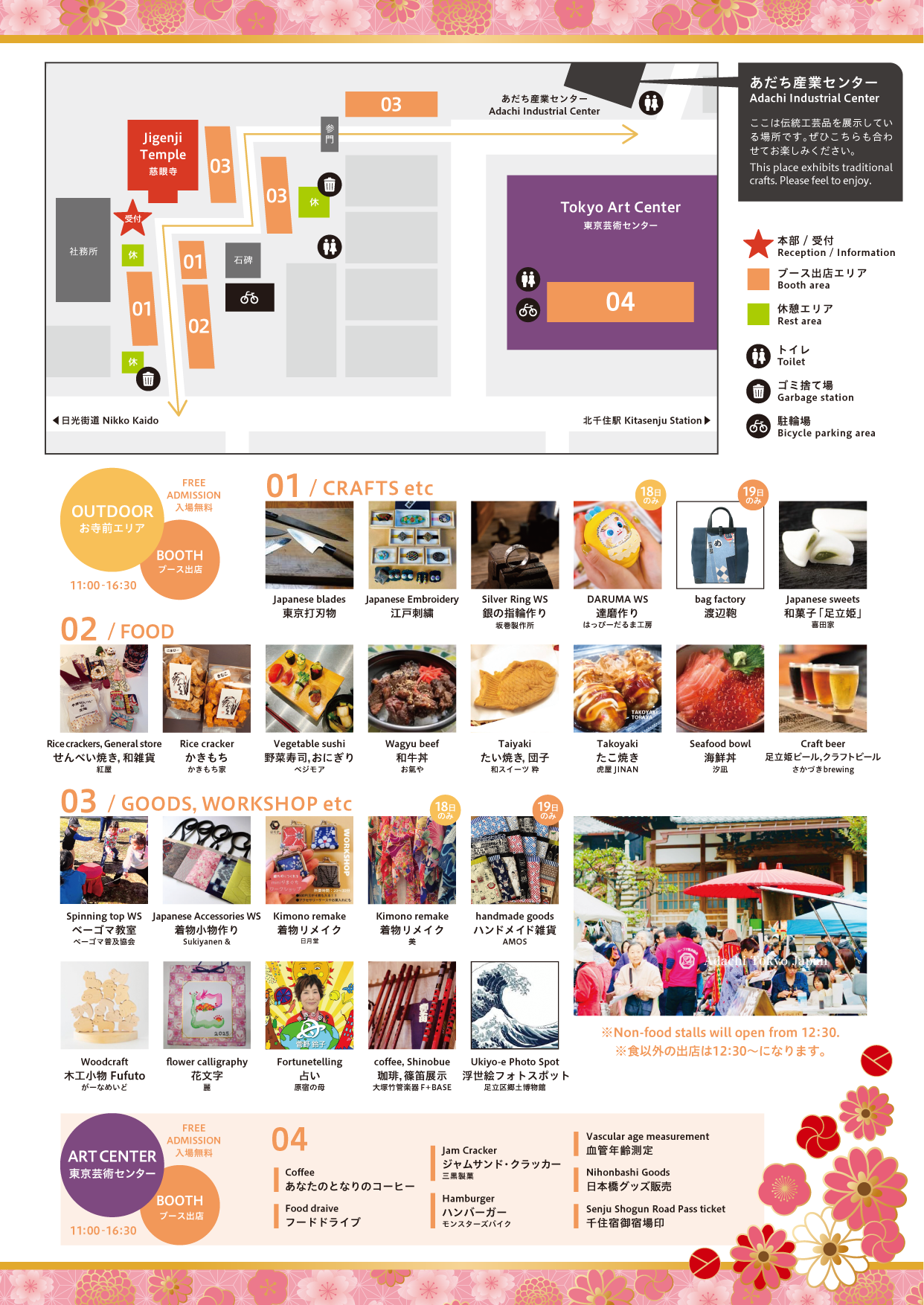 The “Princess Adachi Festival” will be held in Kitasenju on December 18 and 19, 2024! This festival celebrates the 1300th anniversary of the “足立姫Princess Adachi Legend,” which became widely popular during the Edo period, making it a special two days to fully enjoy Japanese culture. Set against the historic Jigenji Temple, there will be plenty of activities including lion dances, samurai experiences, traditional games, and workshops on traditional crafts. The Adachi Hime Parade, which marches through the shopping district, is a must-see! In the evening, after a koto performance and a dinner buffet, a new opera will be performed. With English subtitles, international guests can enjoy it together!
The “Princess Adachi Festival” will be held in Kitasenju on December 18 and 19, 2024! This festival celebrates the 1300th anniversary of the “足立姫Princess Adachi Legend,” which became widely popular during the Edo period, making it a special two days to fully enjoy Japanese culture. Set against the historic Jigenji Temple, there will be plenty of activities including lion dances, samurai experiences, traditional games, and workshops on traditional crafts. The Adachi Hime Parade, which marches through the shopping district, is a must-see! In the evening, after a koto performance and a dinner buffet, a new opera will be performed. With English subtitles, international guests can enjoy it together!
The theme of the festival is ‘wish the pray,’ representing wishes and prayers. Princess Adachi is also known as the ‘Sakura Princess,’ symbolizing the mystical beauty of cherry blossoms that bloom in winter. Through experiences like embroidery and silver crafting, we hope visitors will imbue each step with their personal wishes, offering hope for the coming year and beyond. We aim for this festival to be a place where dreams can come true.
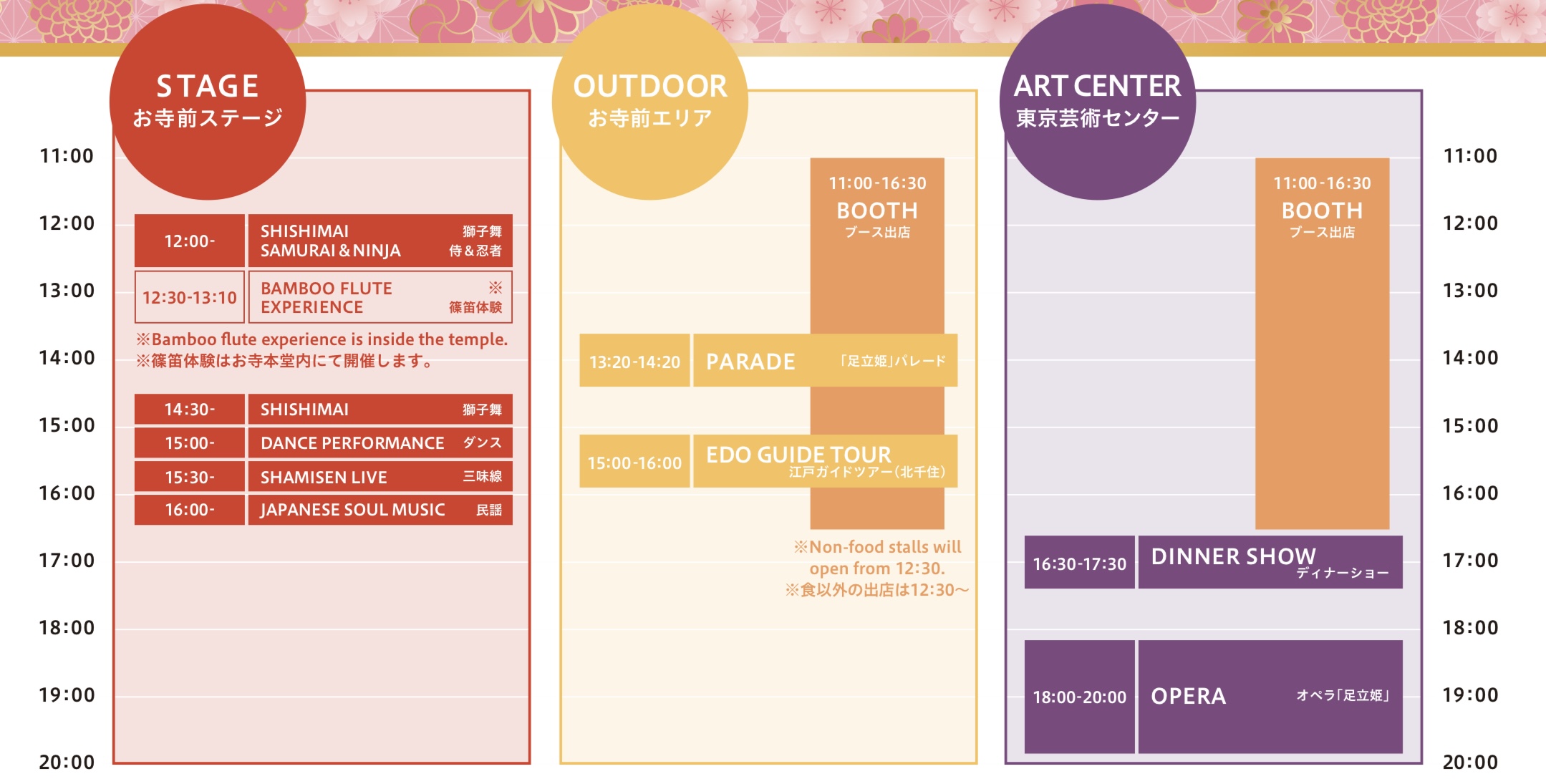
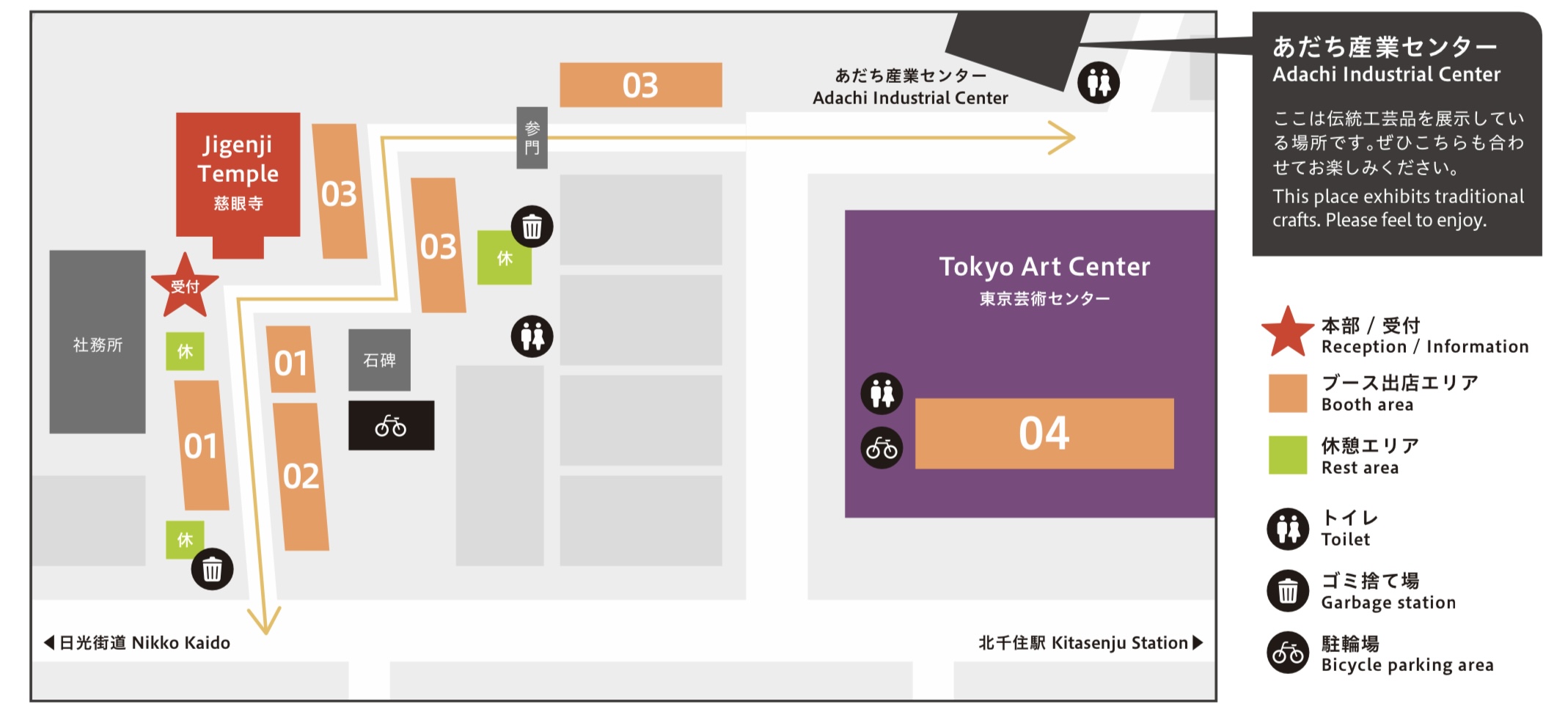
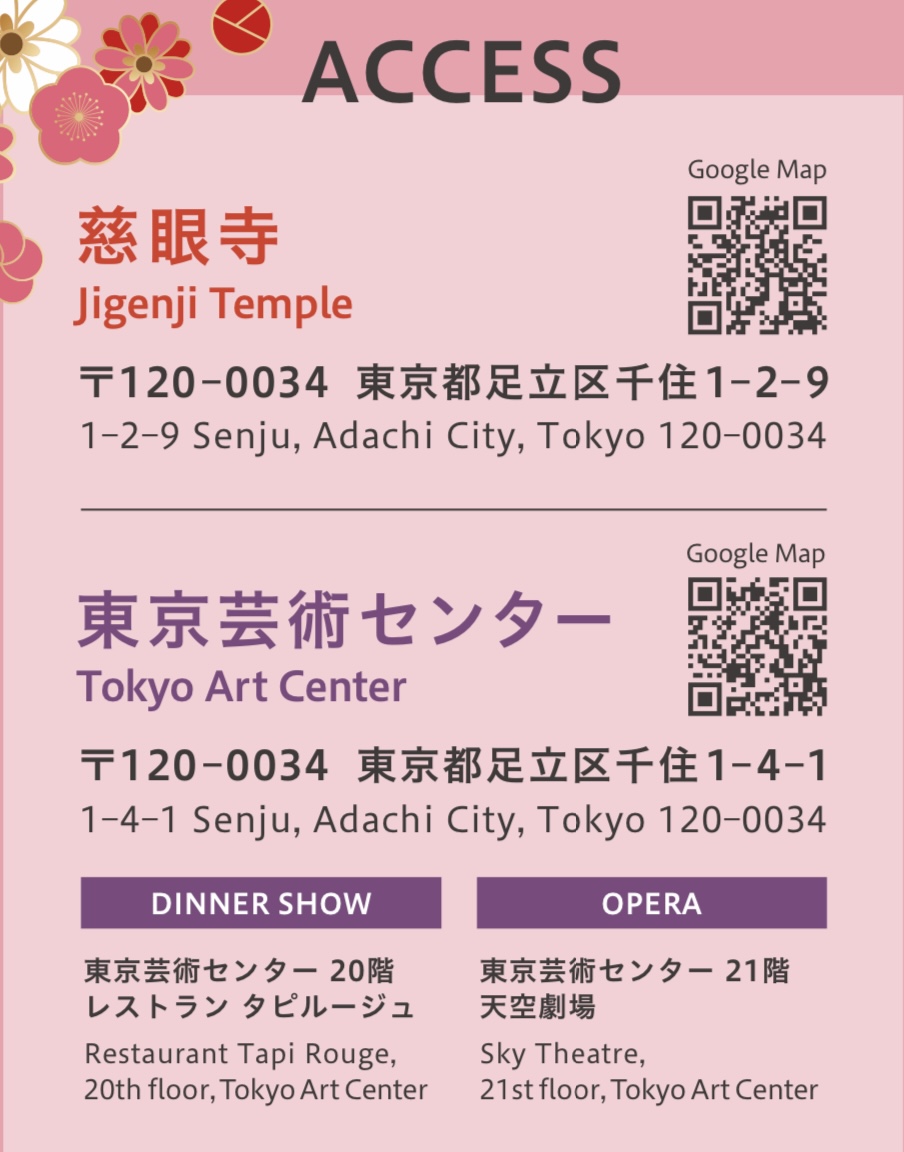
1.Lion-dance and shinobue-performance package Location: Jigenji Temple (1-2-9 Senju, Adachi-ku, Tokyo) Time: 12:00–13:00 (last registration at 11:30) Cost: ¥8,000 (prepayment is required)
2.Lion dance and guided Kita Senju walking-tour package Location: Jigenji Temple & Kita Senju area Time: 14:30–16:00 (last registration at 14:00) Cost: ¥8,000 (prepayment is required)
3.Dinner and Princess Adachi Opera package Location: Art Center of Tokyo (1-4-1 Senju, Adachi-ku, Tokyo) Time: 16:30–20:00 (last registration at 16:00) Cost: ¥25,000 (prepayment is required)
4.Complete package (includes all the above) Cost: ¥33,000 (prepayment is required)
Note: Those who purchase a package can also join the Japan Performing Arts and Gourmet Experience, held at Jigenji Temple from 12:30 until 17:15.
A town where Edo culture remains, with artisan culture and local culture nurtured by the unique topography surrounded by rivers.
With its public baths, retro Showa-era streets, old-fashioned shopping districts, and real life, this small city is one of the most fascinating hidden gems in the country.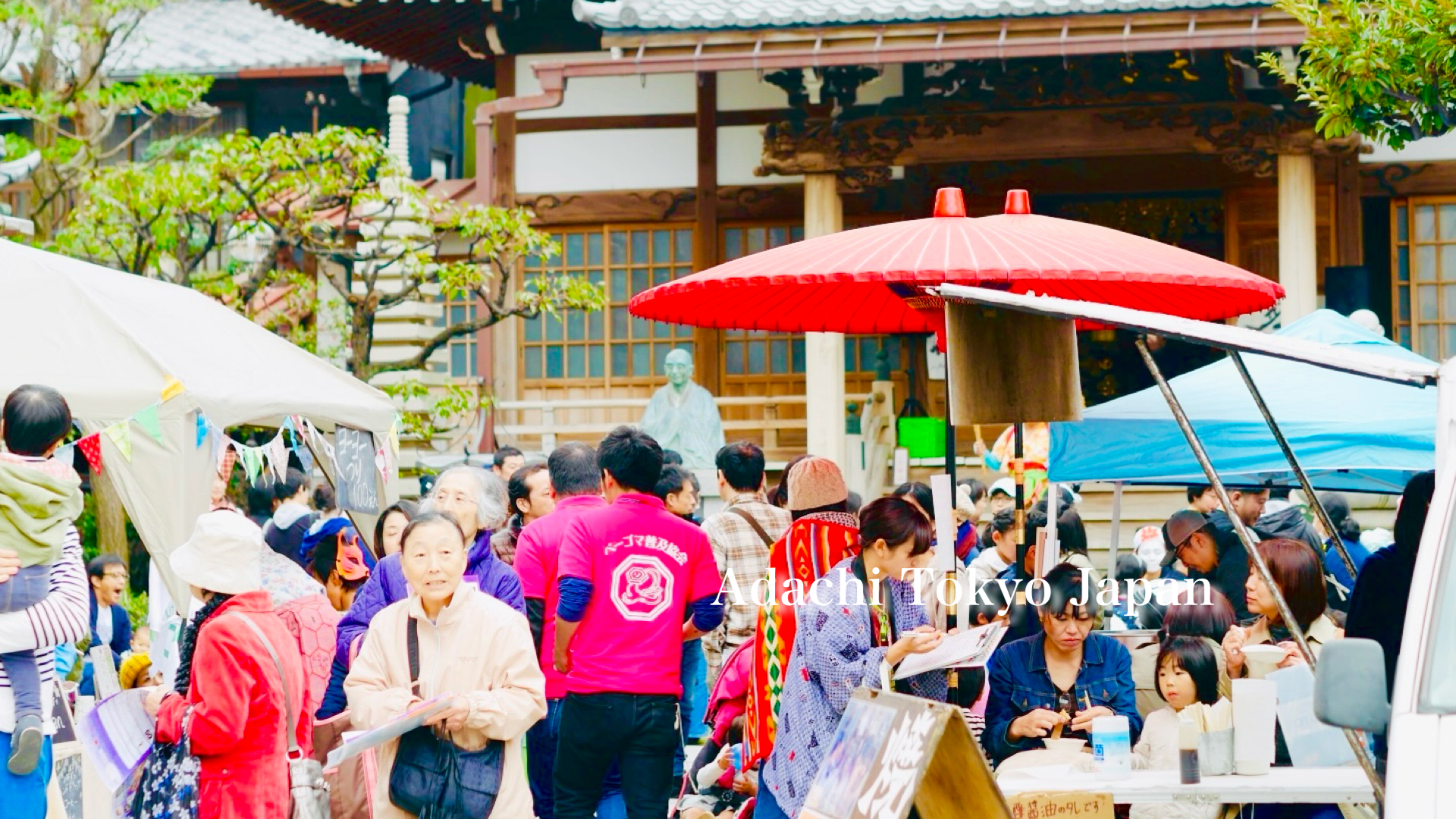
Exclusive Temple Access:
Enjoy rare access to a historic temple marked with the Tokugawa family’s hollyhock crest, a place that’s usually closed to the public. The temple, with its gate that survived wartime fires,
offers a special glimpse into the past and the Tale of Princess Adachi.
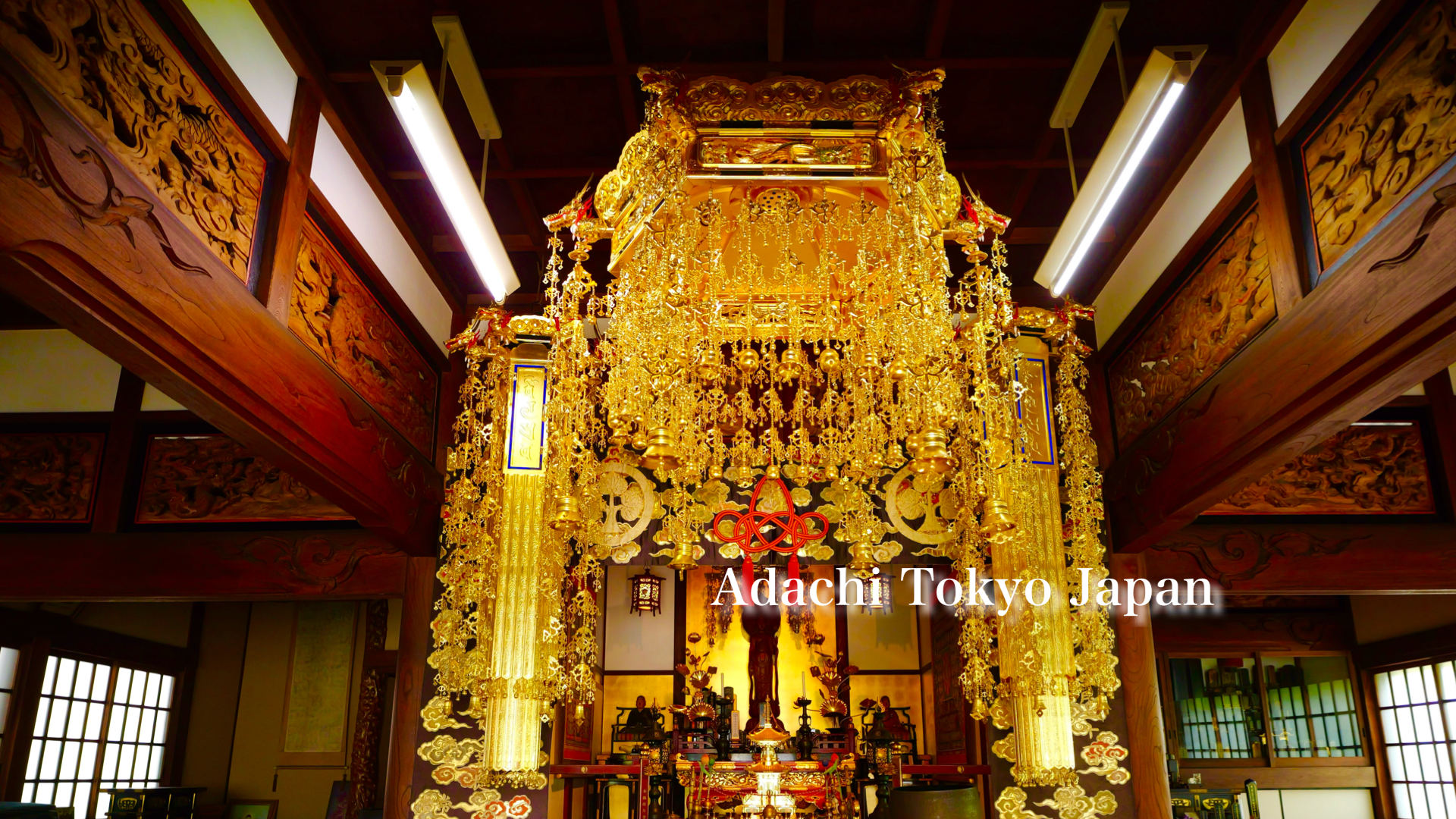

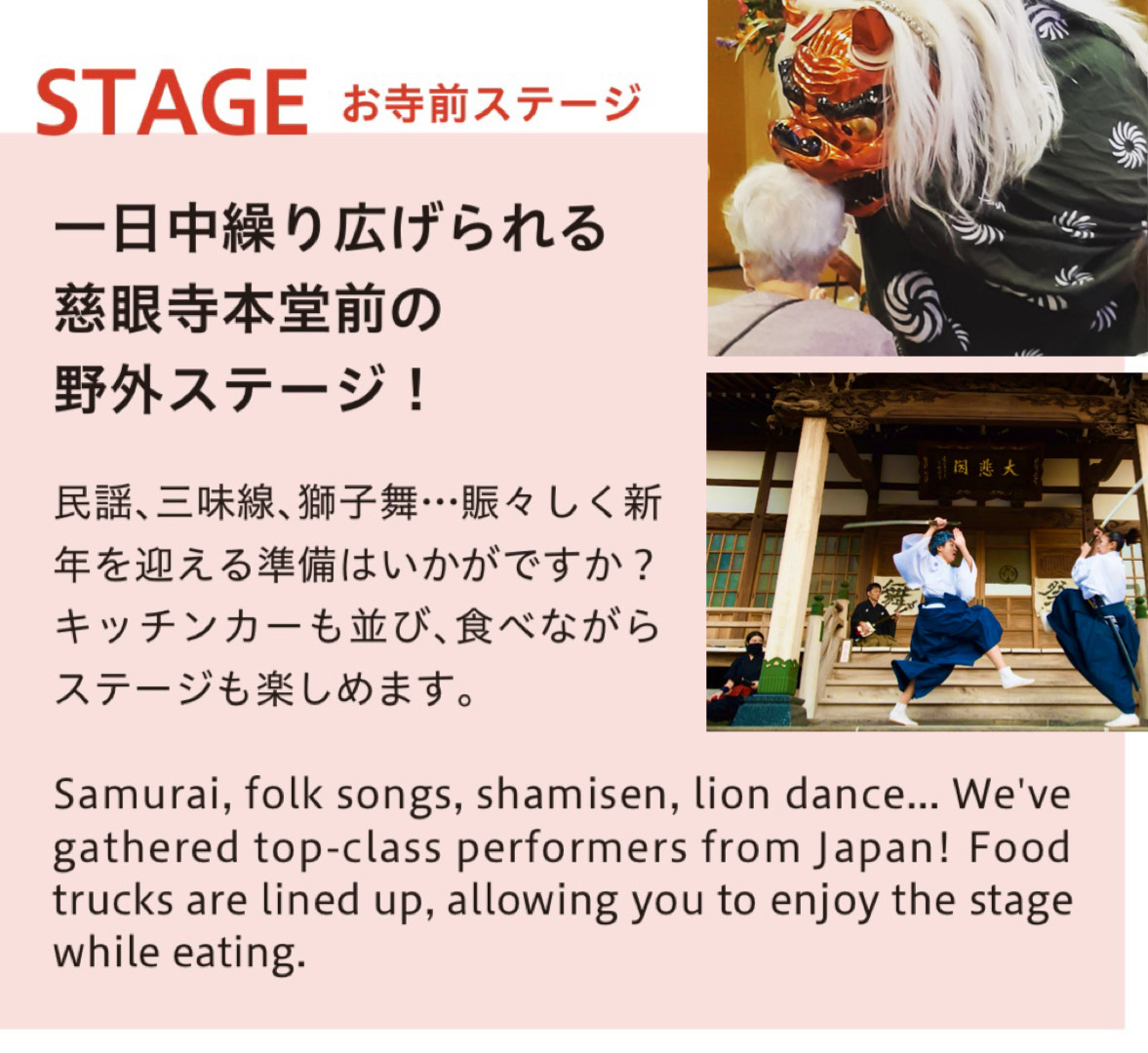
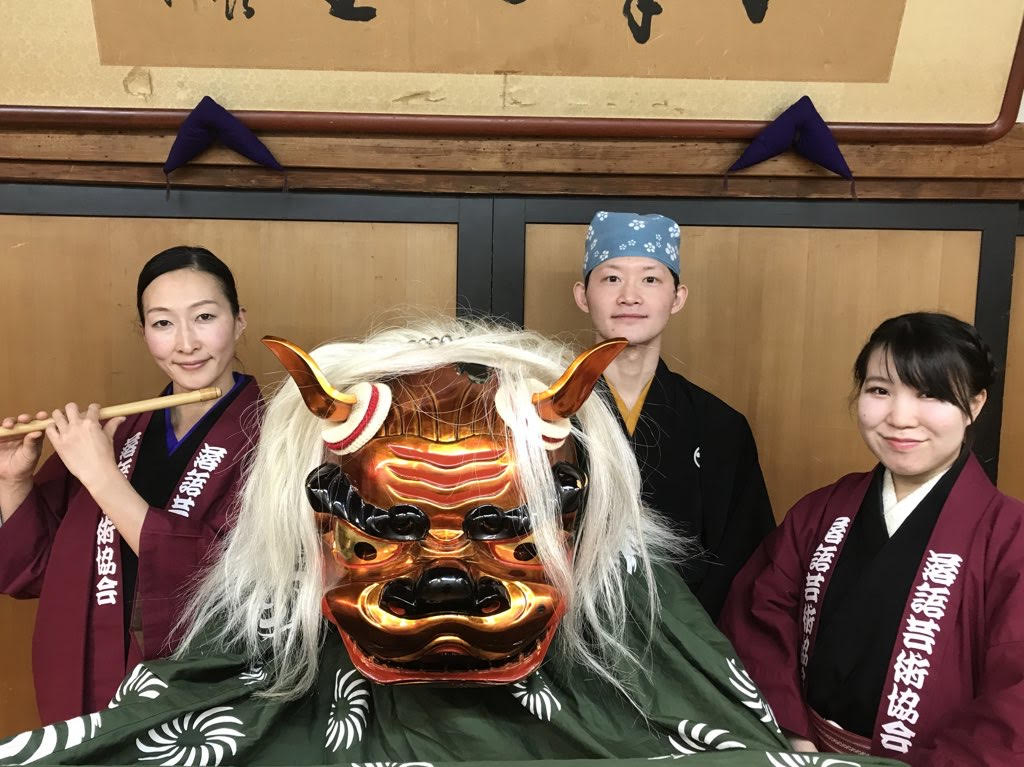
*Lion dancing, a traditional art form essential to Japanese festivals, is said to ward off evil
spirits and bring happiness. You’ll learn about the origins of the lion dance, including the
custom of having your head “bitten,” which is thought to bring good health and boost
academic success.
Enhance your luck with the lion dance and the Princess Adachi pilgrimage, a ritual that has been celebrated for centuries
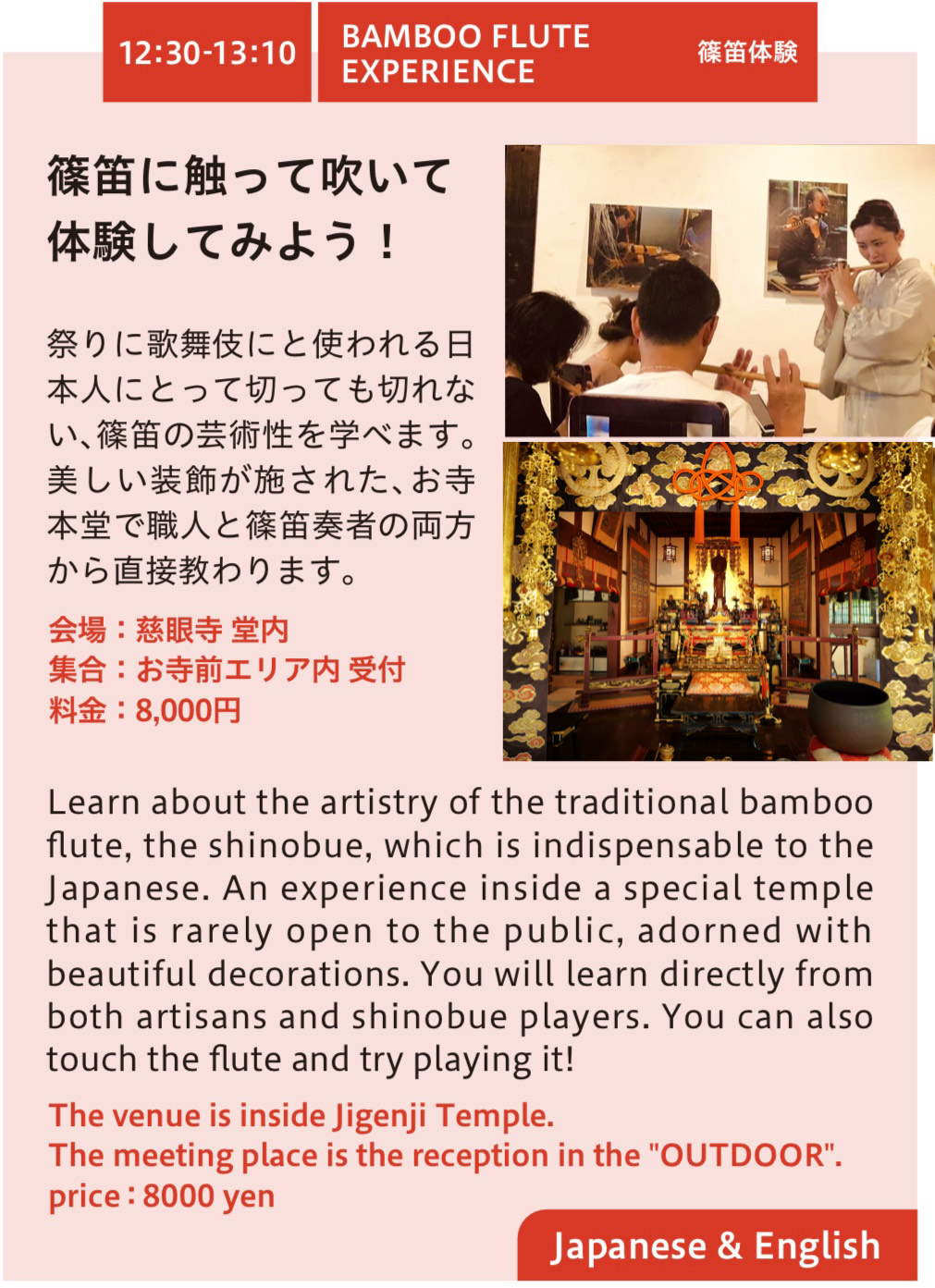
Immerse yourself in the musical artistry of the Shinobue, Japan’s traditional bamboo flute.
You’ll learn from a distinguished Shinobue artist, celebrating 100 years of musical
craftsmanship. The flutes, meticulously crafted from bamboo aged for 10 years, embody the
beauty of this musical tradition. After experiencing a live performance that showcases the
artist’s mastery, you’ll have the rare chance to play the flute yourself in a beautifully
decorated temple—an exclusive space rarely open to the public.
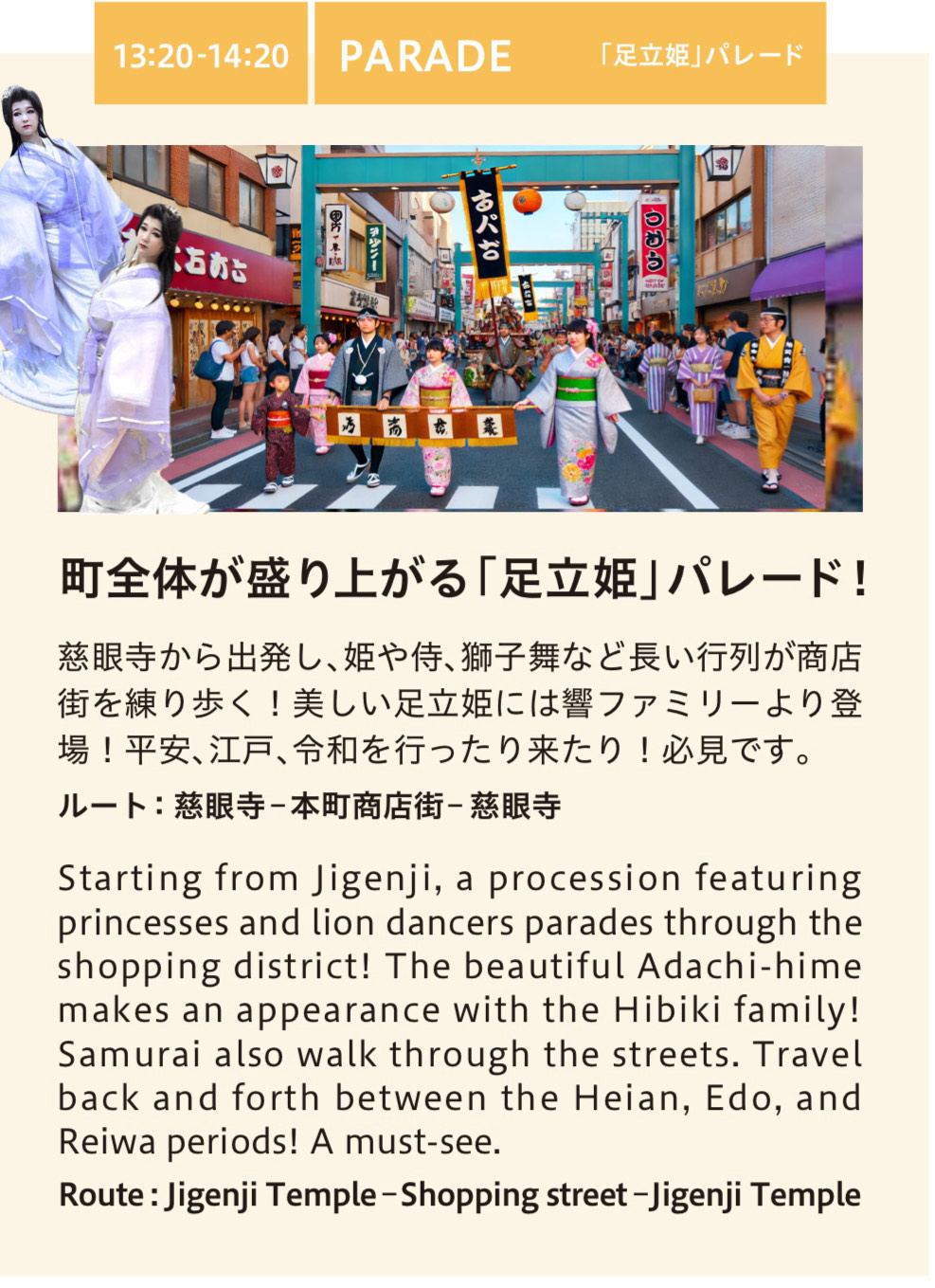
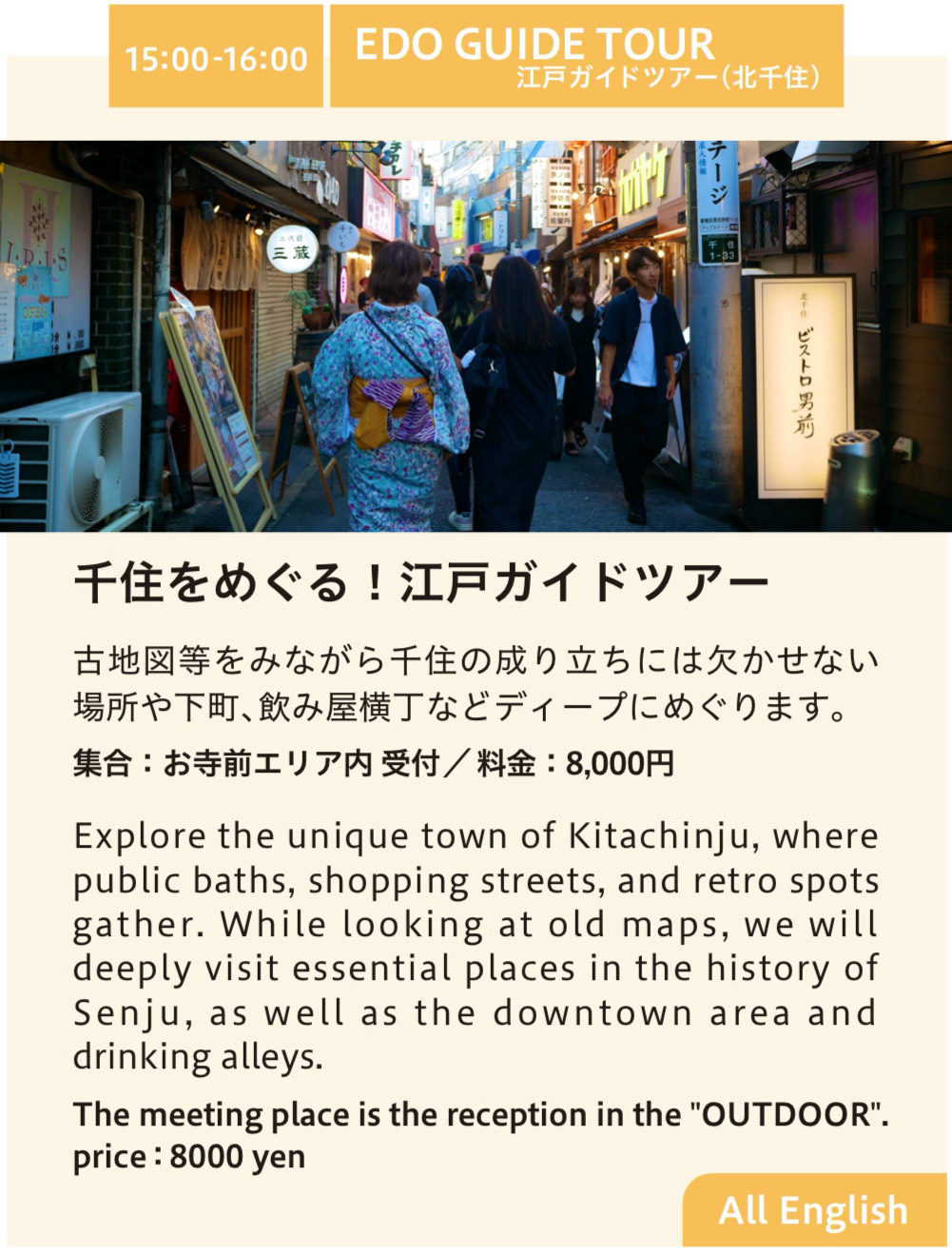
Take a walking tour with detailed English explanations, using old maps to guide you through the area’s rich history and cultural significance from the Edo period, designed specifically for foreign visitors
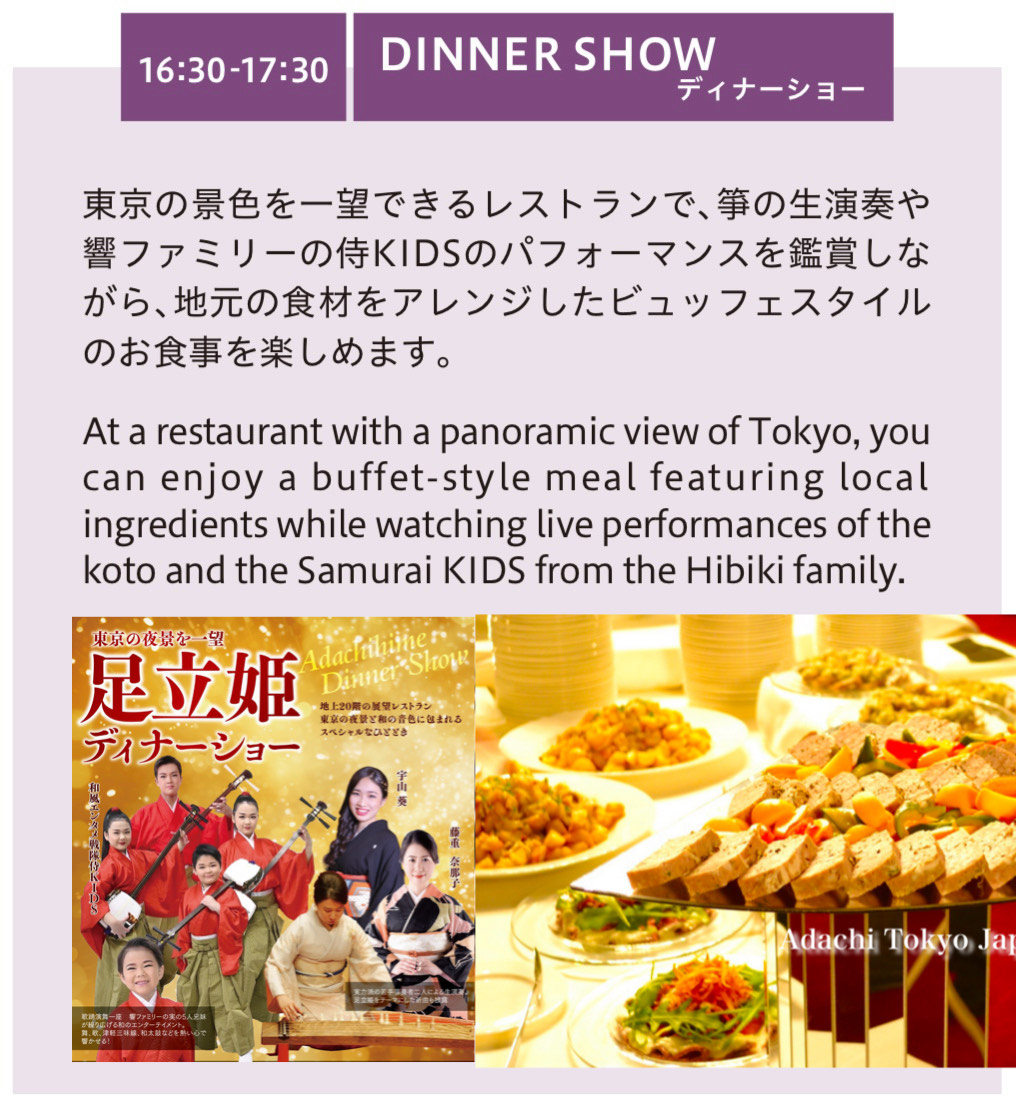
A private dining room with a panoramic view of Tokyo, meals arranged with local ingredients. A buffet, so you don’t have to worry about cultural differences in food preferences.
Enjoy your meal while listening to a live performance of the koto (Japanese stringed instrument) in the private dining room.
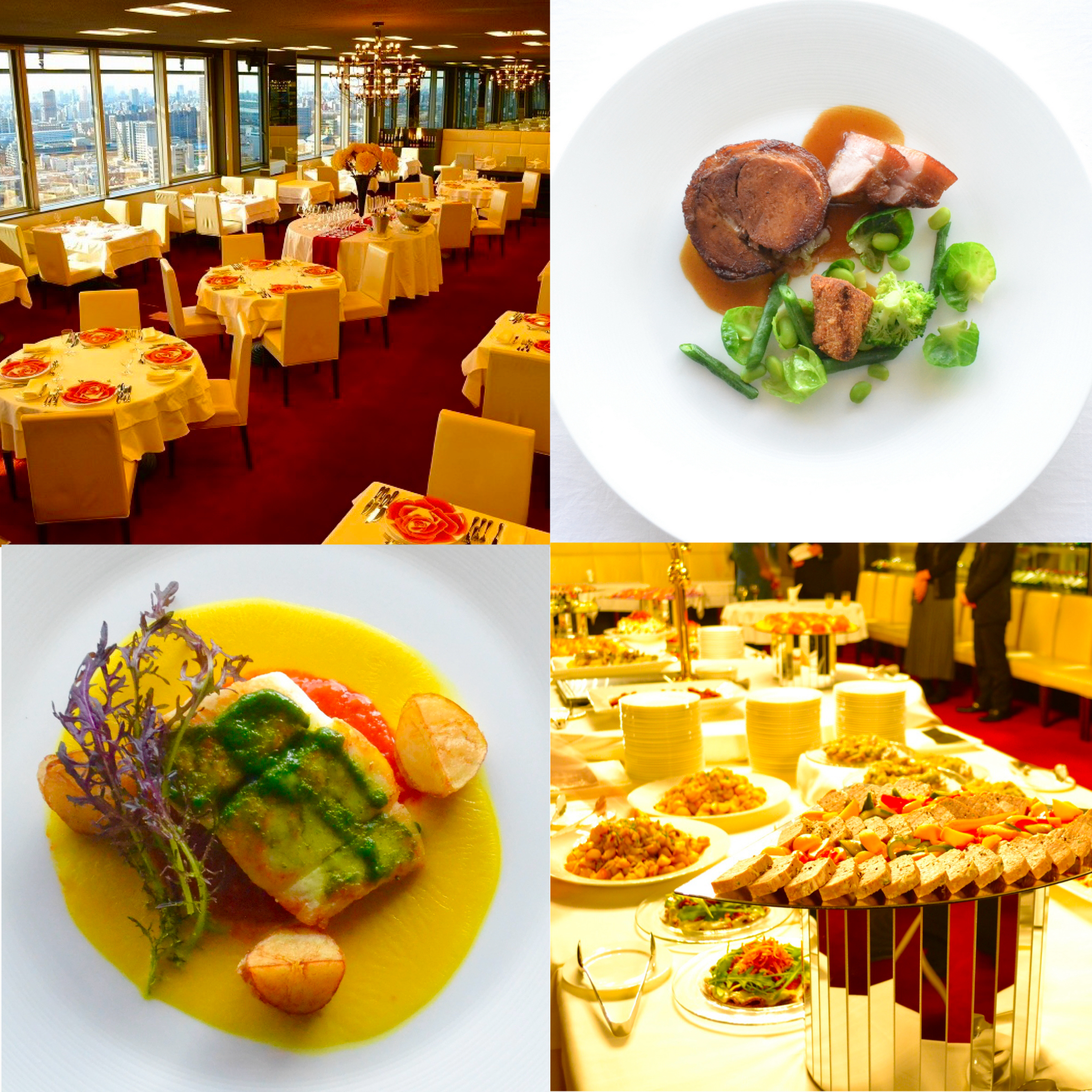
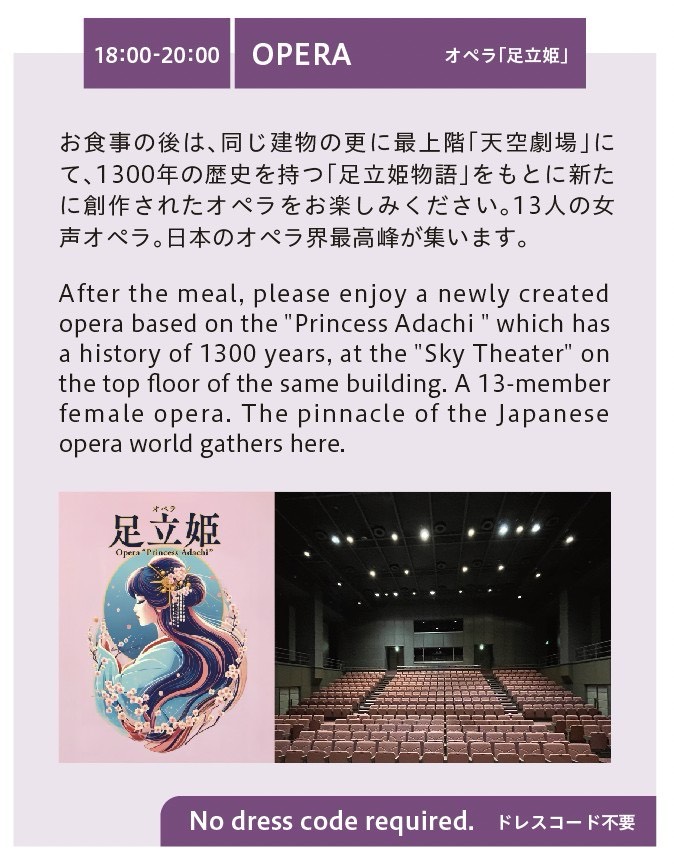

Local gourmet food, artisan workshops,
Japanese accessories for sale, Princess Adachi goods, and much more! Enjoy♪♪♪
■JAPAN SOUL MUSIC(民謡の世界)
Japanese rhythm, Japanese music.
We will deliver Japan`s best shamisen and songs♪
・Folk song singer: Mitsuna Koyama
・Tsugaru shamisen player
Mayu Sugai (*19th only)
Shinobu Kawashima (*18th only)
Oyama Seiyu
日本のリズム、日本の音楽。
日本最高峰の三味線や唄をお届けします♪
・民謡歌手:小山みつな
・津軽三味線奏者
須貝麻由 (※19日のみ)
川嶋志乃舞(※18日のみ)
小山清雄
****************************************
On December 18-19, 2024, the “Princess Adachi Festival” will take place in Kita-Senju, just a short distance from Asakusa and Ueno. This event, revives the 1,300-year-old legend of Princess Adachi, believed to bring happiness in the afterlife. It aims to share Japan’s rich cultural heritage with international visitors.
Experience the magic of the Princess Adachi Festival in Tokyo! 🏮 Immerse yourself in traditional Japanese culture with lion dances, samurai experiences, Edo crafts, and more at this historic temple. Don`t miss the opera with English subtitles, koto performances, and a delicious buffet dinner. 🎎✨
Venue: Jigenji Temple (1-2-9 Senju, Adachi-ku, Tokyo) ,
Languages: The performance is in Japanese, with English subtitles available.
Organizer: @rojicoya
▼For more information on the Princess Adachi Festival: A Celebration of Wishes, please click here: https://rojicoya.jp/adachi-hime/
2024年12月18日から19日に、北千住で「プリンセス足立祭り」が開催されます!🏮✨
日本の伝統文化を広めるRojicoya主催のこのイベントは、1,300年前の足立姫伝説を蘇らせ、来世まで幸せをもたらすと信じられています。👘🎎世界中の方々と日本の豊かな文化遺産を共有する素晴らしい機会です!🎌🌟
会場:慈眼寺(東京都足立区千住1-2-9)北千住駅西口から徒歩約10分
主催 @rojicoya
▼「足立姫フェスティバル~願いを込めたお祭り~」の詳細については、こちらをご覧ください:https://rojicoya.jp/adachi-hime/
#足立姫 #伝統文化 #Rojicoya #文化遺産 #国際交流 #幸せをもたらす #日本の祭り #1300周年 #足立姫フェスティバル #東京 #千住宿400周年 #北千住 #足立区 #rojicoya
#PrincessAdachi #kitasenju #Tokyo #sightseeing #japanexperience #PrincessAdachiFestival #JapaneseCulture #TokyoEvents #TraditionalCrafts #OperaNight #EdoEmbroidery #LocalGourmetFood
#民謡 #野外ステージ #津軽三味線

■JAPAN SOUL MUSIC(民謡の世界)
Japanese rhythm, Japanese music.
We will deliver Japan`s best shamisen and songs♪
・Folk song singer: Mitsuna Koyama
・Tsugaru shamisen player
Mayu Sugai (*19th only)
Shinobu Kawashima (*18th only)
Oyama Seiyu
日本のリズム、日本の音楽。
日本最高峰の三味線や唄をお届けします♪
・民謡歌手:小山みつな
・津軽三味線奏者
須貝麻由 (※19日のみ)
川嶋志乃舞(※18日のみ)
小山清雄
****************************************
On December 18-19, 2024, the “Princess Adachi Festival” will take place in Kita-Senju, just a short distance from Asakusa and Ueno. This event, revives the 1,300-year-old legend of Princess Adachi, believed to bring happiness in the afterlife. It aims to share Japan’s rich cultural heritage with international visitors.
Experience the magic of the Princess Adachi Festival in Tokyo! 🏮 Immerse yourself in traditional Japanese culture with lion dances, samurai experiences, Edo crafts, and more at this historic temple. Don`t miss the opera with English subtitles, koto performances, and a delicious buffet dinner. 🎎✨
Venue: Jigenji Temple (1-2-9 Senju, Adachi-ku, Tokyo) ,
Languages: The performance is in Japanese, with English subtitles available.
Organizer: @rojicoya
▼For more information on the Princess Adachi Festival: A Celebration of Wishes, please click here: https://rojicoya.jp/adachi-hime/
2024年12月18日から19日に、北千住で「プリンセス足立祭り」が開催されます!🏮✨
日本の伝統文化を広めるRojicoya主催のこのイベントは、1,300年前の足立姫伝説を蘇らせ、来世まで幸せをもたらすと信じられています。👘🎎世界中の方々と日本の豊かな文化遺産を共有する素晴らしい機会です!🎌🌟
会場:慈眼寺(東京都足立区千住1-2-9)北千住駅西口から徒歩約10分
主催 @rojicoya
▼「足立姫フェスティバル~願いを込めたお祭り~」の詳細については、こちらをご覧ください:https://rojicoya.jp/adachi-hime/
#足立姫 #伝統文化 #Rojicoya #文化遺産 #国際交流 #幸せをもたらす #日本の祭り #1300周年 #足立姫フェスティバル #東京 #千住宿400周年 #北千住 #足立区 #rojicoya
#PrincessAdachi #kitasenju #Tokyo #sightseeing #japanexperience #PrincessAdachiFestival #JapaneseCulture #TokyoEvents #TraditionalCrafts #OperaNight #EdoEmbroidery #LocalGourmetFood
#民謡 #野外ステージ #津軽三味線
■JAPAN SOUL MUSIC(民謡の世界)
Japanese rhythm, Japanese music.
We will deliver Japan`s best shamisen and songs♪
・Folk song singer: Mitsuna Koyama
・Tsugaru shamisen player
Mayu Sugai (*19th only)
Shinobu Kawashima (*18th only)
Oyama Seiyu
日本のリズム、日本の音楽。
日本最高峰の三味線や唄をお届けします♪
・民謡歌手:小山みつな
・津軽三味線奏者
須貝麻由 (※19日のみ)
川嶋志乃舞(※18日のみ)
小山清雄
****************************************
On December 18-19, 2024, the “Princess Adachi Festival” will take place in Kita-Senju, just a short distance from Asakusa and Ueno. This event, revives the 1,300-year-old legend of Princess Adachi, believed to bring happiness in the afterlife. It aims to share Japan’s rich cultural heritage with international visitors.
Experience the magic of the Princess Adachi Festival in Tokyo! 🏮 Immerse yourself in traditional Japanese culture with lion dances, samurai experiences, Edo crafts, and more at this historic temple. Don`t miss the opera with English subtitles, koto performances, and a delicious buffet dinner. 🎎✨
Venue: Jigenji Temple (1-2-9 Senju, Adachi-ku, Tokyo) ,
Languages: The performance is in Japanese, with English subtitles available.
Organizer: @rojicoya
▼For more information on the Princess Adachi Festival: A Celebration of Wishes, please click here: https://rojicoya.jp/adachi-hime/
2024年12月18日から19日に、北千住で「プリンセス足立祭り」が開催されます!🏮✨
日本の伝統文化を広めるRojicoya主催のこのイベントは、1,300年前の足立姫伝説を蘇らせ、来世まで幸せをもたらすと信じられています。👘🎎世界中の方々と日本の豊かな文化遺産を共有する素晴らしい機会です!🎌🌟
会場:慈眼寺(東京都足立区千住1-2-9)北千住駅西口から徒歩約10分
主催 @rojicoya
▼「足立姫フェスティバル~願いを込めたお祭り~」の詳細については、こちらをご覧ください:https://rojicoya.jp/adachi-hime/
#足立姫 #伝統文化 #Rojicoya #文化遺産 #国際交流 #幸せをもたらす #日本の祭り #1300周年 #足立姫フェスティバル #東京 #千住宿400周年 #北千住 #足立区 #rojicoya
#PrincessAdachi #kitasenju #Tokyo #sightseeing #japanexperience #PrincessAdachiFestival #JapaneseCulture #TokyoEvents #TraditionalCrafts #OperaNight #EdoEmbroidery #LocalGourmetFood
#民謡 #野外ステージ #津軽三味線

■JAPAN SOUL MUSIC(民謡の世界)
Japanese rhythm, Japanese music.
We will deliver Japan`s best shamisen and songs♪
・Folk song singer: Mitsuna Koyama
・Tsugaru shamisen player
Mayu Sugai (*19th only)
Shinobu Kawashima (*18th only)
Oyama Seiyu
日本のリズム、日本の音楽。
日本最高峰の三味線や唄をお届けします♪
・民謡歌手:小山みつな
・津軽三味線奏者
須貝麻由 (※19日のみ)
川嶋志乃舞(※18日のみ)
小山清雄
****************************************
On December 18-19, 2024, the “Princess Adachi Festival” will take place in Kita-Senju, just a short distance from Asakusa and Ueno. This event, revives the 1,300-year-old legend of Princess Adachi, believed to bring happiness in the afterlife. It aims to share Japan’s rich cultural heritage with international visitors.
Experience the magic of the Princess Adachi Festival in Tokyo! 🏮 Immerse yourself in traditional Japanese culture with lion dances, samurai experiences, Edo crafts, and more at this historic temple. Don`t miss the opera with English subtitles, koto performances, and a delicious buffet dinner. 🎎✨
Venue: Jigenji Temple (1-2-9 Senju, Adachi-ku, Tokyo) ,
Languages: The performance is in Japanese, with English subtitles available.
Organizer: @rojicoya
▼For more information on the Princess Adachi Festival: A Celebration of Wishes, please click here: https://rojicoya.jp/adachi-hime/
2024年12月18日から19日に、北千住で「プリンセス足立祭り」が開催されます!🏮✨
日本の伝統文化を広めるRojicoya主催のこのイベントは、1,300年前の足立姫伝説を蘇らせ、来世まで幸せをもたらすと信じられています。👘🎎世界中の方々と日本の豊かな文化遺産を共有する素晴らしい機会です!🎌🌟
会場:慈眼寺(東京都足立区千住1-2-9)北千住駅西口から徒歩約10分
主催 @rojicoya
▼「足立姫フェスティバル~願いを込めたお祭り~」の詳細については、こちらをご覧ください:https://rojicoya.jp/adachi-hime/
#足立姫 #伝統文化 #Rojicoya #文化遺産 #国際交流 #幸せをもたらす #日本の祭り #1300周年 #足立姫フェスティバル #東京 #千住宿400周年 #北千住 #足立区 #rojicoya
#PrincessAdachi #kitasenju #Tokyo #sightseeing #japanexperience #PrincessAdachiFestival #JapaneseCulture #TokyoEvents #TraditionalCrafts #OperaNight #EdoEmbroidery #LocalGourmetFood
#民謡 #野外ステージ #津軽三味線
■JAPAN SOUL MUSIC(民謡の世界)
Japanese rhythm, Japanese music.
We will deliver Japan`s best shamisen and songs♪
・Folk song singer: Mitsuna Koyama
・Tsugaru shamisen player
Mayu Sugai (*19th only)
Shinobu Kawashima (*18th only)
Oyama Seiyu
日本のリズム、日本の音楽。
日本最高峰の三味線や唄をお届けします♪
・民謡歌手:小山みつな
・津軽三味線奏者
須貝麻由 (※19日のみ)
川嶋志乃舞(※18日のみ)
小山清雄
****************************************
On December 18-19, 2024, the “Princess Adachi Festival” will take place in Kita-Senju, just a short distance from Asakusa and Ueno. This event, revives the 1,300-year-old legend of Princess Adachi, believed to bring happiness in the afterlife. It aims to share Japan’s rich cultural heritage with international visitors.
Experience the magic of the Princess Adachi Festival in Tokyo! 🏮 Immerse yourself in traditional Japanese culture with lion dances, samurai experiences, Edo crafts, and more at this historic temple. Don`t miss the opera with English subtitles, koto performances, and a delicious buffet dinner. 🎎✨
Venue: Jigenji Temple (1-2-9 Senju, Adachi-ku, Tokyo) ,
Languages: The performance is in Japanese, with English subtitles available.
Organizer: @rojicoya
▼For more information on the Princess Adachi Festival: A Celebration of Wishes, please click here: https://rojicoya.jp/adachi-hime/
2024年12月18日から19日に、北千住で「プリンセス足立祭り」が開催されます!🏮✨
日本の伝統文化を広めるRojicoya主催のこのイベントは、1,300年前の足立姫伝説を蘇らせ、来世まで幸せをもたらすと信じられています。👘🎎世界中の方々と日本の豊かな文化遺産を共有する素晴らしい機会です!🎌🌟
会場:慈眼寺(東京都足立区千住1-2-9)北千住駅西口から徒歩約10分
主催 @rojicoya
▼「足立姫フェスティバル~願いを込めたお祭り~」の詳細については、こちらをご覧ください:https://rojicoya.jp/adachi-hime/
#足立姫 #伝統文化 #Rojicoya #文化遺産 #国際交流 #幸せをもたらす #日本の祭り #1300周年 #足立姫フェスティバル #東京 #千住宿400周年 #北千住 #足立区 #rojicoya
#PrincessAdachi #kitasenju #Tokyo #sightseeing #japanexperience #PrincessAdachiFestival #JapaneseCulture #TokyoEvents #TraditionalCrafts #OperaNight #EdoEmbroidery #LocalGourmetFood
#民謡 #野外ステージ #津軽三味線

■JAPAN SOUL MUSIC(民謡の世界)
Japanese rhythm, Japanese music.
We will deliver Japan`s best shamisen and songs♪
・Folk song singer: Mitsuna Koyama
・Tsugaru shamisen player
Mayu Sugai (*19th only)
Shinobu Kawashima (*18th only)
Oyama Seiyu
日本のリズム、日本の音楽。
日本最高峰の三味線や唄をお届けします♪
・民謡歌手:小山みつな
・津軽三味線奏者
須貝麻由 (※19日のみ)
川嶋志乃舞(※18日のみ)
小山清雄
****************************************
On December 18-19, 2024, the “Princess Adachi Festival” will take place in Kita-Senju, just a short distance from Asakusa and Ueno. This event, revives the 1,300-year-old legend of Princess Adachi, believed to bring happiness in the afterlife. It aims to share Japan’s rich cultural heritage with international visitors.
Experience the magic of the Princess Adachi Festival in Tokyo! 🏮 Immerse yourself in traditional Japanese culture with lion dances, samurai experiences, Edo crafts, and more at this historic temple. Don`t miss the opera with English subtitles, koto performances, and a delicious buffet dinner. 🎎✨
Venue: Jigenji Temple (1-2-9 Senju, Adachi-ku, Tokyo) ,
Languages: The performance is in Japanese, with English subtitles available.
Organizer: @rojicoya
▼For more information on the Princess Adachi Festival: A Celebration of Wishes, please click here: https://rojicoya.jp/adachi-hime/
2024年12月18日から19日に、北千住で「プリンセス足立祭り」が開催されます!🏮✨
日本の伝統文化を広めるRojicoya主催のこのイベントは、1,300年前の足立姫伝説を蘇らせ、来世まで幸せをもたらすと信じられています。👘🎎世界中の方々と日本の豊かな文化遺産を共有する素晴らしい機会です!🎌🌟
会場:慈眼寺(東京都足立区千住1-2-9)北千住駅西口から徒歩約10分
主催 @rojicoya
▼「足立姫フェスティバル~願いを込めたお祭り~」の詳細については、こちらをご覧ください:https://rojicoya.jp/adachi-hime/
#足立姫 #伝統文化 #Rojicoya #文化遺産 #国際交流 #幸せをもたらす #日本の祭り #1300周年 #足立姫フェスティバル #東京 #千住宿400周年 #北千住 #足立区 #rojicoya
#PrincessAdachi #kitasenju #Tokyo #sightseeing #japanexperience #PrincessAdachiFestival #JapaneseCulture #TokyoEvents #TraditionalCrafts #OperaNight #EdoEmbroidery #LocalGourmetFood
#民謡 #野外ステージ #津軽三味線
■JAPAN SOUL MUSIC(民謡の世界)
Japanese rhythm, Japanese music.
We will deliver Japan`s best shamisen and songs♪
・Folk song singer: Mitsuna Koyama
・Tsugaru shamisen player
Mayu Sugai (*19th only)
Shinobu Kawashima (*18th only)
Oyama Seiyu
日本のリズム、日本の音楽。
日本最高峰の三味線や唄をお届けします♪
・民謡歌手:小山みつな
・津軽三味線奏者
須貝麻由 (※19日のみ)
川嶋志乃舞(※18日のみ)
小山清雄
****************************************
On December 18-19, 2024, the “Princess Adachi Festival” will take place in Kita-Senju, just a short distance from Asakusa and Ueno. This event, revives the 1,300-year-old legend of Princess Adachi, believed to bring happiness in the afterlife. It aims to share Japan’s rich cultural heritage with international visitors.
Experience the magic of the Princess Adachi Festival in Tokyo! 🏮 Immerse yourself in traditional Japanese culture with lion dances, samurai experiences, Edo crafts, and more at this historic temple. Don`t miss the opera with English subtitles, koto performances, and a delicious buffet dinner. 🎎✨
Venue: Jigenji Temple (1-2-9 Senju, Adachi-ku, Tokyo) ,
Languages: The performance is in Japanese, with English subtitles available.
Organizer: @rojicoya
▼For more information on the Princess Adachi Festival: A Celebration of Wishes, please click here: https://rojicoya.jp/adachi-hime/
2024年12月18日から19日に、北千住で「プリンセス足立祭り」が開催されます!🏮✨
日本の伝統文化を広めるRojicoya主催のこのイベントは、1,300年前の足立姫伝説を蘇らせ、来世まで幸せをもたらすと信じられています。👘🎎世界中の方々と日本の豊かな文化遺産を共有する素晴らしい機会です!🎌🌟
会場:慈眼寺(東京都足立区千住1-2-9)北千住駅西口から徒歩約10分
主催 @rojicoya
▼「足立姫フェスティバル~願いを込めたお祭り~」の詳細については、こちらをご覧ください:https://rojicoya.jp/adachi-hime/
#足立姫 #伝統文化 #Rojicoya #文化遺産 #国際交流 #幸せをもたらす #日本の祭り #1300周年 #足立姫フェスティバル #東京 #千住宿400周年 #北千住 #足立区 #rojicoya
#PrincessAdachi #kitasenju #Tokyo #sightseeing #japanexperience #PrincessAdachiFestival #JapaneseCulture #TokyoEvents #TraditionalCrafts #OperaNight #EdoEmbroidery #LocalGourmetFood
#民謡 #野外ステージ #津軽三味線

■JAPAN SOUL MUSIC(民謡の世界)
Japanese rhythm, Japanese music.
We will deliver Japan`s best shamisen and songs♪
・Folk song singer: Mitsuna Koyama
・Tsugaru shamisen player
Mayu Sugai (*19th only)
Shinobu Kawashima (*18th only)
Oyama Seiyu
日本のリズム、日本の音楽。
日本最高峰の三味線や唄をお届けします♪
・民謡歌手:小山みつな
・津軽三味線奏者
須貝麻由 (※19日のみ)
川嶋志乃舞(※18日のみ)
小山清雄
****************************************
On December 18-19, 2024, the “Princess Adachi Festival” will take place in Kita-Senju, just a short distance from Asakusa and Ueno. This event, revives the 1,300-year-old legend of Princess Adachi, believed to bring happiness in the afterlife. It aims to share Japan’s rich cultural heritage with international visitors.
Experience the magic of the Princess Adachi Festival in Tokyo! 🏮 Immerse yourself in traditional Japanese culture with lion dances, samurai experiences, Edo crafts, and more at this historic temple. Don`t miss the opera with English subtitles, koto performances, and a delicious buffet dinner. 🎎✨
Venue: Jigenji Temple (1-2-9 Senju, Adachi-ku, Tokyo) ,
Languages: The performance is in Japanese, with English subtitles available.
Organizer: @rojicoya
▼For more information on the Princess Adachi Festival: A Celebration of Wishes, please click here: https://rojicoya.jp/adachi-hime/
2024年12月18日から19日に、北千住で「プリンセス足立祭り」が開催されます!🏮✨
日本の伝統文化を広めるRojicoya主催のこのイベントは、1,300年前の足立姫伝説を蘇らせ、来世まで幸せをもたらすと信じられています。👘🎎世界中の方々と日本の豊かな文化遺産を共有する素晴らしい機会です!🎌🌟
会場:慈眼寺(東京都足立区千住1-2-9)北千住駅西口から徒歩約10分
主催 @rojicoya
▼「足立姫フェスティバル~願いを込めたお祭り~」の詳細については、こちらをご覧ください:https://rojicoya.jp/adachi-hime/
#足立姫 #伝統文化 #Rojicoya #文化遺産 #国際交流 #幸せをもたらす #日本の祭り #1300周年 #足立姫フェスティバル #東京 #千住宿400周年 #北千住 #足立区 #rojicoya
#PrincessAdachi #kitasenju #Tokyo #sightseeing #japanexperience #PrincessAdachiFestival #JapaneseCulture #TokyoEvents #TraditionalCrafts #OperaNight #EdoEmbroidery #LocalGourmetFood
#民謡 #野外ステージ #津軽三味線
■Samurai ninja show(サムライ忍者ショー)
A collaboration show between samurai and ninja!
Check out the traditional techniques of samurai and ninja living today! ✨
・Samurai : Oka Musashi
・Ninja : Narashino
侍と忍者が繰り広げるコラボショー!
現在に生きる侍と忍者の伝統技をご覧ください!✨
・サムライ:岡武蔵
・忍者:習志野
****************************************
On December 18-19, 2024, the “Princess Adachi Festival” will take place in Kita-Senju, just a short distance from Asakusa and Ueno. This event, revives the 1,300-year-old legend of Princess Adachi, believed to bring happiness in the afterlife. It aims to share Japan’s rich cultural heritage with international visitors.
Experience the magic of the Princess Adachi Festival in Tokyo! 🏮 Immerse yourself in traditional Japanese culture with lion dances, samurai experiences, Edo crafts, and more at this historic temple. Don`t miss the opera with English subtitles, koto performances, and a delicious buffet dinner. 🎎✨
Venue: Jigenji Temple (1-2-9 Senju, Adachi-ku, Tokyo) ,
Languages: The performance is in Japanese, with English subtitles available.
Organizer: @rojicoya
▼For more information on the Princess Adachi Festival: A Celebration of Wishes, please click here: https://rojicoya.jp/adachi-hime/
2024年12月18日から19日に、北千住で「プリンセス足立祭り」が開催されます!🏮✨
日本の伝統文化を広めるRojicoya主催のこのイベントは、1,300年前の足立姫伝説を蘇らせ、来世まで幸せをもたらすと信じられています。👘🎎世界中の方々と日本の豊かな文化遺産を共有する素晴らしい機会です!🎌🌟
会場:慈眼寺(東京都足立区千住1-2-9)北千住駅西口から徒歩約10分
主催 @rojicoya
▼「足立姫フェスティバル~願いを込めたお祭り~」の詳細については、こちらをご覧ください:https://rojicoya.jp/adachi-hime/
#足立姫 #伝統文化 #Rojicoya #文化遺産 #国際交流 #幸せをもたらす #日本の祭り #1300周年 #足立姫フェスティバル #東京 #千住宿400周年 #北千住 #足立区 #rojicoya
#PrincessAdachi #kitasenju #Tokyo #sightseeing #japanexperience #PrincessAdachiFestival #JapaneseCulture #TokyoEvents #TraditionalCrafts #OperaNight #EdoEmbroidery #LocalGourmetFood
#サムライ忍者ショー #野外ステージ

■Samurai ninja show(サムライ忍者ショー)
A collaboration show between samurai and ninja!
Check out the traditional techniques of samurai and ninja living today! ✨
・Samurai : Oka Musashi
・Ninja : Narashino
侍と忍者が繰り広げるコラボショー!
現在に生きる侍と忍者の伝統技をご覧ください!✨
・サムライ:岡武蔵
・忍者:習志野
****************************************
On December 18-19, 2024, the “Princess Adachi Festival” will take place in Kita-Senju, just a short distance from Asakusa and Ueno. This event, revives the 1,300-year-old legend of Princess Adachi, believed to bring happiness in the afterlife. It aims to share Japan’s rich cultural heritage with international visitors.
Experience the magic of the Princess Adachi Festival in Tokyo! 🏮 Immerse yourself in traditional Japanese culture with lion dances, samurai experiences, Edo crafts, and more at this historic temple. Don`t miss the opera with English subtitles, koto performances, and a delicious buffet dinner. 🎎✨
Venue: Jigenji Temple (1-2-9 Senju, Adachi-ku, Tokyo) ,
Languages: The performance is in Japanese, with English subtitles available.
Organizer: @rojicoya
▼For more information on the Princess Adachi Festival: A Celebration of Wishes, please click here: https://rojicoya.jp/adachi-hime/
2024年12月18日から19日に、北千住で「プリンセス足立祭り」が開催されます!🏮✨
日本の伝統文化を広めるRojicoya主催のこのイベントは、1,300年前の足立姫伝説を蘇らせ、来世まで幸せをもたらすと信じられています。👘🎎世界中の方々と日本の豊かな文化遺産を共有する素晴らしい機会です!🎌🌟
会場:慈眼寺(東京都足立区千住1-2-9)北千住駅西口から徒歩約10分
主催 @rojicoya
▼「足立姫フェスティバル~願いを込めたお祭り~」の詳細については、こちらをご覧ください:https://rojicoya.jp/adachi-hime/
#足立姫 #伝統文化 #Rojicoya #文化遺産 #国際交流 #幸せをもたらす #日本の祭り #1300周年 #足立姫フェスティバル #東京 #千住宿400周年 #北千住 #足立区 #rojicoya
#PrincessAdachi #kitasenju #Tokyo #sightseeing #japanexperience #PrincessAdachiFestival #JapaneseCulture #TokyoEvents #TraditionalCrafts #OperaNight #EdoEmbroidery #LocalGourmetFood
#サムライ忍者ショー #野外ステージ
■Silver ring-making experience(シルバーリング体験)
Very popular! This is an experience where you can make your own original silver ring, the only one in the world. It takes about 20 to 30 minutes.
The size will be measured on the spot, so you can experience it with only your body ^_^
Edo silverware craftsman, a traditional craftsman of Adachi-ku, will be here.
大人気!世界に一つだけ、オリジナルの銀の指輪を自分で作られる体験です。
所要時間20〜30分ほど。
サイズはその場で計りますので身一つで体験できます^_^
足立区の伝統工芸師 江戸銀器の職人さんが来られますよ♪♪/12:30〜16:30
※写真はイメージです
****************************************
On December 18-19, 2024, the “Princess Adachi Festival” will take place in Kita-Senju, just a short distance from Asakusa and Ueno. This event, revives the 1,300-year-old legend of Princess Adachi, believed to bring happiness in the afterlife. It aims to share Japan’s rich cultural heritage with international visitors.
Experience the magic of the Princess Adachi Festival in Tokyo! 🏮 Immerse yourself in traditional Japanese culture with lion dances, samurai experiences, Edo crafts, and more at this historic temple. Don`t miss the opera with English subtitles, koto performances, and a delicious buffet dinner. 🎎✨
Venue: Jigenji Temple (1-2-9 Senju, Adachi-ku, Tokyo) ,
Languages: The performance is in Japanese, with English subtitles available.
Organizer: @rojicoya
▼For more information on the Princess Adachi Festival: A Celebration of Wishes, please click here: https://rojicoya.jp/adachi-hime/
2024年12月18日から19日に、北千住で「プリンセス足立祭り」が開催されます!🏮✨
日本の伝統文化を広めるRojicoya主催のこのイベントは、1,300年前の足立姫伝説を蘇らせ、来世まで幸せをもたらすと信じられています。👘🎎世界中の方々と日本の豊かな文化遺産を共有する素晴らしい機会です!🎌🌟
会場:慈眼寺(東京都足立区千住1-2-9)北千住駅西口から徒歩約10分
主催 @rojicoya
▼「足立姫フェスティバル~願いを込めたお祭り~」の詳細については、こちらをご覧ください:https://rojicoya.jp/adachi-hime/
#足立姫 #伝統文化 #Rojicoya #文化遺産 #国際交流 #幸せをもたらす #日本の祭り #1300周年 #足立姫フェスティバル #東京 #千住宿400周年 #北千住 #足立区 #rojicoya
#PrincessAdachi #kitasenju #Tokyo #sightseeing #japanexperience #PrincessAdachiFestival #JapaneseCulture #TokyoEvents #TraditionalCrafts #OperaNight #EdoEmbroidery #LocalGourmetFood
#シルバーリング #体験

■Silver ring-making experience(シルバーリング体験)
Very popular! This is an experience where you can make your own original silver ring, the only one in the world. It takes about 20 to 30 minutes.
The size will be measured on the spot, so you can experience it with only your body ^_^
Edo silverware craftsman, a traditional craftsman of Adachi-ku, will be here.
大人気!世界に一つだけ、オリジナルの銀の指輪を自分で作られる体験です。
所要時間20〜30分ほど。
サイズはその場で計りますので身一つで体験できます^_^
足立区の伝統工芸師 江戸銀器の職人さんが来られますよ♪♪/12:30〜16:30
※写真はイメージです
****************************************
On December 18-19, 2024, the “Princess Adachi Festival” will take place in Kita-Senju, just a short distance from Asakusa and Ueno. This event, revives the 1,300-year-old legend of Princess Adachi, believed to bring happiness in the afterlife. It aims to share Japan’s rich cultural heritage with international visitors.
Experience the magic of the Princess Adachi Festival in Tokyo! 🏮 Immerse yourself in traditional Japanese culture with lion dances, samurai experiences, Edo crafts, and more at this historic temple. Don`t miss the opera with English subtitles, koto performances, and a delicious buffet dinner. 🎎✨
Venue: Jigenji Temple (1-2-9 Senju, Adachi-ku, Tokyo) ,
Languages: The performance is in Japanese, with English subtitles available.
Organizer: @rojicoya
▼For more information on the Princess Adachi Festival: A Celebration of Wishes, please click here: https://rojicoya.jp/adachi-hime/
2024年12月18日から19日に、北千住で「プリンセス足立祭り」が開催されます!🏮✨
日本の伝統文化を広めるRojicoya主催のこのイベントは、1,300年前の足立姫伝説を蘇らせ、来世まで幸せをもたらすと信じられています。👘🎎世界中の方々と日本の豊かな文化遺産を共有する素晴らしい機会です!🎌🌟
会場:慈眼寺(東京都足立区千住1-2-9)北千住駅西口から徒歩約10分
主催 @rojicoya
▼「足立姫フェスティバル~願いを込めたお祭り~」の詳細については、こちらをご覧ください:https://rojicoya.jp/adachi-hime/
#足立姫 #伝統文化 #Rojicoya #文化遺産 #国際交流 #幸せをもたらす #日本の祭り #1300周年 #足立姫フェスティバル #東京 #千住宿400周年 #北千住 #足立区 #rojicoya
#PrincessAdachi #kitasenju #Tokyo #sightseeing #japanexperience #PrincessAdachiFestival #JapaneseCulture #TokyoEvents #TraditionalCrafts #OperaNight #EdoEmbroidery #LocalGourmetFood
#シルバーリング #体験
■Edo embroidery/(江戸刺繍体験)
Certified as a traditional Adachi Ward craft
Would you like to experience beautiful Edo embroidery? The colorful brooches and earrings with sparkling gold threads are very beautiful.
You can experience and take your own work of art with you! Why don’t you wear something you put your heart and soul into? Great gifts too✨!
-Time required: 1 hour, elementary school students and up
What kind of threads and tools do you use? We also offer a free experience of just sewing ♪
足立区伝統工芸品認定。
美しい江戸刺繍を体験してみませんか?キラキラした金の糸にカラフルなブローチやピアスなどとっても素敵です♪♪
体験して自分の作品を持ち替えられる!心を込めたものを身につけて見ませんか??プレゼントも素敵✨
-所要時間1時間 小学生以上
どんな糸、道具を使っているの?縫うだけの体験も無料でご用意しております♪
****************************************
On December 18-19, 2024, the “Princess Adachi Festival” will take place in Kita-Senju, just a short distance from Asakusa and Ueno. This event, revives the 1,300-year-old legend of Princess Adachi, believed to bring happiness in the afterlife. It aims to share Japan’s rich cultural heritage with international visitors.
Experience the magic of the Princess Adachi Festival in Tokyo! 🏮 Immerse yourself in traditional Japanese culture with lion dances, samurai experiences, Edo crafts, and more at this historic temple. Don`t miss the opera with English subtitles, koto performances, and a delicious buffet dinner. 🎎✨
Venue: Jigenji Temple (1-2-9 Senju, Adachi-ku, Tokyo) ,
Languages: The performance is in Japanese, with English subtitles available.
Organizer: @rojicoya
▼For more information on the Princess Adachi Festival: A Celebration of Wishes, please click here: https://rojicoya.jp/adachi-hime/
2024年12月18日から19日に、北千住で「プリンセス足立祭り」が開催されます!🏮✨
日本の伝統文化を広めるRojicoya主催のこのイベントは、1,300年前の足立姫伝説を蘇らせ、来世まで幸せをもたらすと信じられています。👘🎎世界中の方々と日本の豊かな文化遺産を共有する素晴らしい機会です!🎌🌟
会場:慈眼寺(東京都足立区千住1-2-9)北千住駅西口から徒歩約10分
主催 @rojicoya
▼「足立姫フェスティバル~願いを込めたお祭り~」の詳細については、こちらをご覧ください:https://rojicoya.jp/adachi-hime/
#足立姫 #伝統文化 #Rojicoya #文化遺産 #国際交流 #幸せをもたらす #日本の祭り #1300周年 #足立姫フェスティバル #東京 #千住宿400周年 #北千住 #足立区 #rojicoya
#PrincessAdachi #kitasenju #Tokyo #sightseeing #japanexperience #PrincessAdachiFestival #JapaneseCulture #TokyoEvents #TraditionalCrafts #OperaNight #EdoEmbroidery #LocalGourmetFood
#江戸刺繍 #体験

■Edo embroidery/(江戸刺繍体験)
Certified as a traditional Adachi Ward craft
Would you like to experience beautiful Edo embroidery? The colorful brooches and earrings with sparkling gold threads are very beautiful.
You can experience and take your own work of art with you! Why don’t you wear something you put your heart and soul into? Great gifts too✨!
-Time required: 1 hour, elementary school students and up
What kind of threads and tools do you use? We also offer a free experience of just sewing ♪
足立区伝統工芸品認定。
美しい江戸刺繍を体験してみませんか?キラキラした金の糸にカラフルなブローチやピアスなどとっても素敵です♪♪
体験して自分の作品を持ち替えられる!心を込めたものを身につけて見ませんか??プレゼントも素敵✨
-所要時間1時間 小学生以上
どんな糸、道具を使っているの?縫うだけの体験も無料でご用意しております♪
****************************************
On December 18-19, 2024, the “Princess Adachi Festival” will take place in Kita-Senju, just a short distance from Asakusa and Ueno. This event, revives the 1,300-year-old legend of Princess Adachi, believed to bring happiness in the afterlife. It aims to share Japan’s rich cultural heritage with international visitors.
Experience the magic of the Princess Adachi Festival in Tokyo! 🏮 Immerse yourself in traditional Japanese culture with lion dances, samurai experiences, Edo crafts, and more at this historic temple. Don`t miss the opera with English subtitles, koto performances, and a delicious buffet dinner. 🎎✨
Venue: Jigenji Temple (1-2-9 Senju, Adachi-ku, Tokyo) ,
Languages: The performance is in Japanese, with English subtitles available.
Organizer: @rojicoya
▼For more information on the Princess Adachi Festival: A Celebration of Wishes, please click here: https://rojicoya.jp/adachi-hime/
2024年12月18日から19日に、北千住で「プリンセス足立祭り」が開催されます!🏮✨
日本の伝統文化を広めるRojicoya主催のこのイベントは、1,300年前の足立姫伝説を蘇らせ、来世まで幸せをもたらすと信じられています。👘🎎世界中の方々と日本の豊かな文化遺産を共有する素晴らしい機会です!🎌🌟
会場:慈眼寺(東京都足立区千住1-2-9)北千住駅西口から徒歩約10分
主催 @rojicoya
▼「足立姫フェスティバル~願いを込めたお祭り~」の詳細については、こちらをご覧ください:https://rojicoya.jp/adachi-hime/
#足立姫 #伝統文化 #Rojicoya #文化遺産 #国際交流 #幸せをもたらす #日本の祭り #1300周年 #足立姫フェスティバル #東京 #千住宿400周年 #北千住 #足立区 #rojicoya
#PrincessAdachi #kitasenju #Tokyo #sightseeing #japanexperience #PrincessAdachiFestival #JapaneseCulture #TokyoEvents #TraditionalCrafts #OperaNight #EdoEmbroidery #LocalGourmetFood
#江戸刺繍 #体験
■Kimono remake /StoreName:NICHIGETSU-DO/(着物リメイク/日月堂)
▷▶▷We will be holding a workshop on mini gaguguchi charms!
Please rest assured that the work process is made without sewing ✨
We use an easy original kit that even small children who can use scissors can experience.
It takes about 30 minutes.
We have plenty of kimono fabric available, so please enjoy the luxurious luster and feel of pure silk to your heart`s content! !
▷▶▷miniがまぐちチャームのワークショップを行います!
作業工程では、縫わずにつくりますのでご安心ください✨
ハサミが使える小さなお子様から体験可能な簡単オリジナルキットを使用します。
所要時間30分程度です。
着物地をたっぷりご用意しますので、贅沢な正絹(シルク)ならではの品のある光沢や肌触りを思う存分、お楽しみください!!
****************************************
On December 18-19, 2024, the “Princess Adachi Festival” will take place in Kita-Senju, just a short distance from Asakusa and Ueno. This event, revives the 1,300-year-old legend of Princess Adachi, believed to bring happiness in the afterlife. It aims to share Japan’s rich cultural heritage with international visitors.
Experience the magic of the Princess Adachi Festival in Tokyo! 🏮 Immerse yourself in traditional Japanese culture with lion dances, samurai experiences, Edo crafts, and more at this historic temple. Don`t miss the opera with English subtitles, koto performances, and a delicious buffet dinner. 🎎✨
Venue: Jigenji Temple (1-2-9 Senju, Adachi-ku, Tokyo) ,
Languages: The performance is in Japanese, with English subtitles available.
Organizer: @rojicoya
▼For more information on the Princess Adachi Festival: A Celebration of Wishes, please click here: https://rojicoya.jp/adachi-hime/
2024年12月18日から19日に、北千住で「プリンセス足立祭り」が開催されます!🏮✨
日本の伝統文化を広めるRojicoya主催のこのイベントは、1,300年前の足立姫伝説を蘇らせ、来世まで幸せをもたらすと信じられています。👘🎎世界中の方々と日本の豊かな文化遺産を共有する素晴らしい機会です!🎌🌟
会場:慈眼寺(東京都足立区千住1-2-9)北千住駅西口から徒歩約10分
主催 @rojicoya
▼「足立姫フェスティバル~願いを込めたお祭り~」の詳細については、こちらをご覧ください:https://rojicoya.jp/adachi-hime/
#足立姫 #伝統文化 #Rojicoya #文化遺産 #国際交流 #幸せをもたらす #日本の祭り #1300周年 #足立姫フェスティバル #東京 #千住宿400周年 #北千住 #足立区 #rojicoya
#PrincessAdachi #kitasenju #Tokyo #sightseeing #japanexperience #PrincessAdachiFestival #JapaneseCulture #TokyoEvents #TraditionalCrafts #OperaNight #EdoEmbroidery #LocalGourmetFood
#がまぐちチャーム #着物リメイク

■Kimono remake /StoreName:NICHIGETSU-DO/(着物リメイク/日月堂)
▷▶▷We will be holding a workshop on mini gaguguchi charms!
Please rest assured that the work process is made without sewing ✨
We use an easy original kit that even small children who can use scissors can experience.
It takes about 30 minutes.
We have plenty of kimono fabric available, so please enjoy the luxurious luster and feel of pure silk to your heart`s content! !
▷▶▷miniがまぐちチャームのワークショップを行います!
作業工程では、縫わずにつくりますのでご安心ください✨
ハサミが使える小さなお子様から体験可能な簡単オリジナルキットを使用します。
所要時間30分程度です。
着物地をたっぷりご用意しますので、贅沢な正絹(シルク)ならではの品のある光沢や肌触りを思う存分、お楽しみください!!
****************************************
On December 18-19, 2024, the “Princess Adachi Festival” will take place in Kita-Senju, just a short distance from Asakusa and Ueno. This event, revives the 1,300-year-old legend of Princess Adachi, believed to bring happiness in the afterlife. It aims to share Japan’s rich cultural heritage with international visitors.
Experience the magic of the Princess Adachi Festival in Tokyo! 🏮 Immerse yourself in traditional Japanese culture with lion dances, samurai experiences, Edo crafts, and more at this historic temple. Don`t miss the opera with English subtitles, koto performances, and a delicious buffet dinner. 🎎✨
Venue: Jigenji Temple (1-2-9 Senju, Adachi-ku, Tokyo) ,
Languages: The performance is in Japanese, with English subtitles available.
Organizer: @rojicoya
▼For more information on the Princess Adachi Festival: A Celebration of Wishes, please click here: https://rojicoya.jp/adachi-hime/
2024年12月18日から19日に、北千住で「プリンセス足立祭り」が開催されます!🏮✨
日本の伝統文化を広めるRojicoya主催のこのイベントは、1,300年前の足立姫伝説を蘇らせ、来世まで幸せをもたらすと信じられています。👘🎎世界中の方々と日本の豊かな文化遺産を共有する素晴らしい機会です!🎌🌟
会場:慈眼寺(東京都足立区千住1-2-9)北千住駅西口から徒歩約10分
主催 @rojicoya
▼「足立姫フェスティバル~願いを込めたお祭り~」の詳細については、こちらをご覧ください:https://rojicoya.jp/adachi-hime/
#足立姫 #伝統文化 #Rojicoya #文化遺産 #国際交流 #幸せをもたらす #日本の祭り #1300周年 #足立姫フェスティバル #東京 #千住宿400周年 #北千住 #足立区 #rojicoya
#PrincessAdachi #kitasenju #Tokyo #sightseeing #japanexperience #PrincessAdachiFestival #JapaneseCulture #TokyoEvents #TraditionalCrafts #OperaNight #EdoEmbroidery #LocalGourmetFood
#がまぐちチャーム #着物リメイク
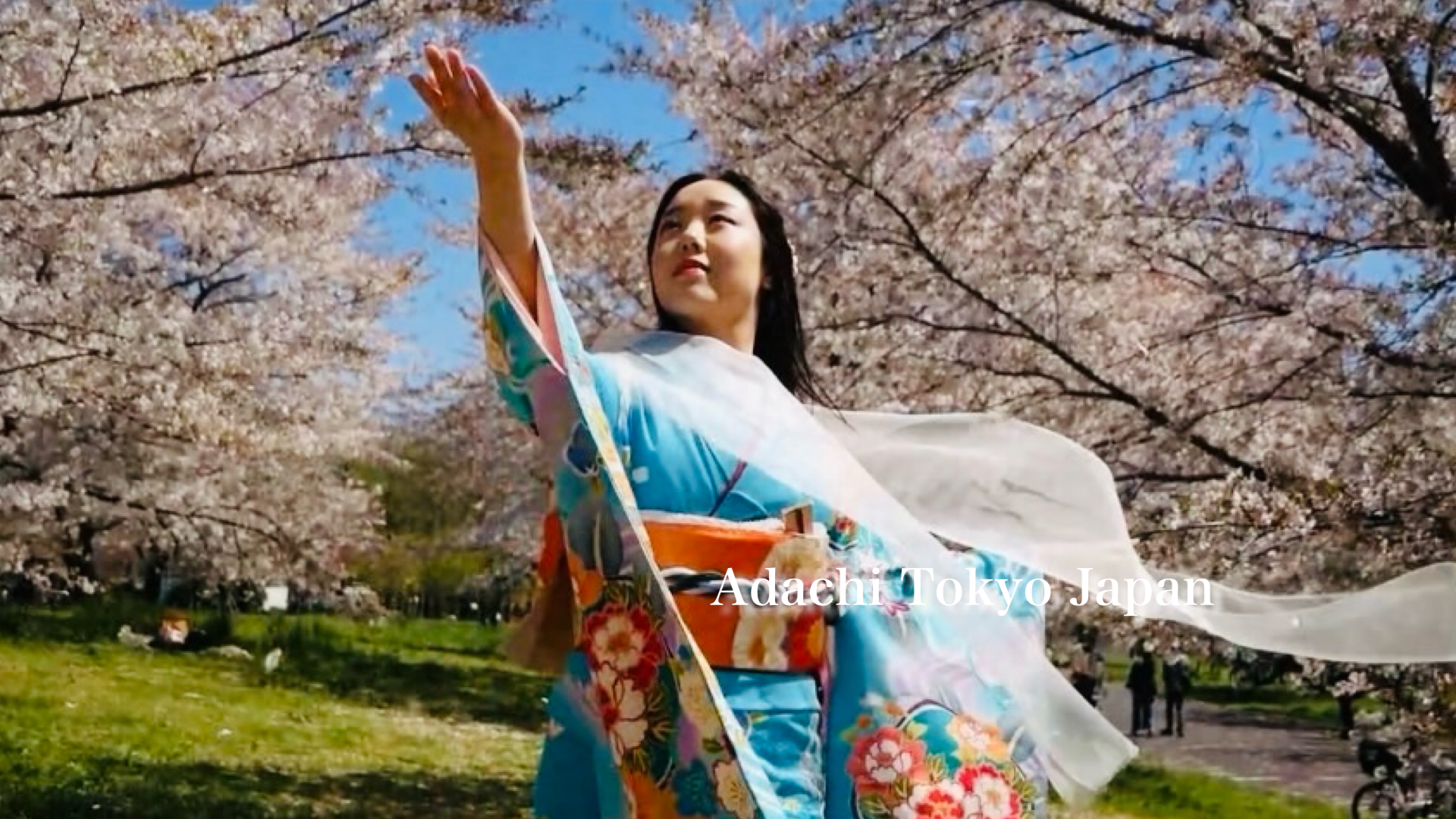
Adachi Hime is a central figure in a legend told in Musashi Province’s Adachi District about 1,300 years ago. She met an unfortunate death due to a political marriage, and before mourning her, six temples were built in the area, each enshrining an image of Amitabha Buddha. Her tragic fate and its impact on the region are deeply ingrained in the history and culture of Adachi Ward.
The “Six Amitabha Pilgrimage” originates from the act of mourning Adachi Hime, where Kobo Daishi (Kukai) carved six Amitabha Buddha statues from a single tree in one night, placing each in six temples built for this purpose. This pilgrimage became extremely popular during the mid-Edo period. Although it’s called the Six Amitabha, the pilgrimage typically includes visiting eight Amitabha statues, adding two more called “leftover” and “remaining.”
The pilgrimage coincided with the cherry blossom season. The Five-Colored Sakura was cherished as “Arakawa Embankment’s Five-Colored Sakura” during the Meiji period and is beloved by many. However, due to increased traffic and visitors, the vitality of the cherry trees declined, and after World War II, they were cut down for firewood, temporarily disappearing. Later, to revive “Arakawa Embankment’s Five-Colored Sakura,” a 4.4km stretch of cherry trees was planted along the left bank of the Arakawa River, featuring Satosakura (village cherry trees).
Tokyo’s Kita Senju area has a rich and fascinating history—a history that is still strongly felt today. Once an important post town on the route between Edo (now Tokyo) and Nikko, this charming district is filled with historic temples, ancient shrines, and retro shopping streets. Although it retains a nostalgic Showa-period atmosphere, the area has all the modern conveniences of a thriving Tokyo neighborhood.
Host rojicoya: Email rojicoya@gmail.com
Rojicoya is involved in activities to promote tourism in Tokyo and the Kitasenju area. Always offering Japanese cultural experiences for inbound visitors. Flower arrangement, calligraphy, Samurai experience, Shamisen, Koto experience, etc. Click here to make a reservation.
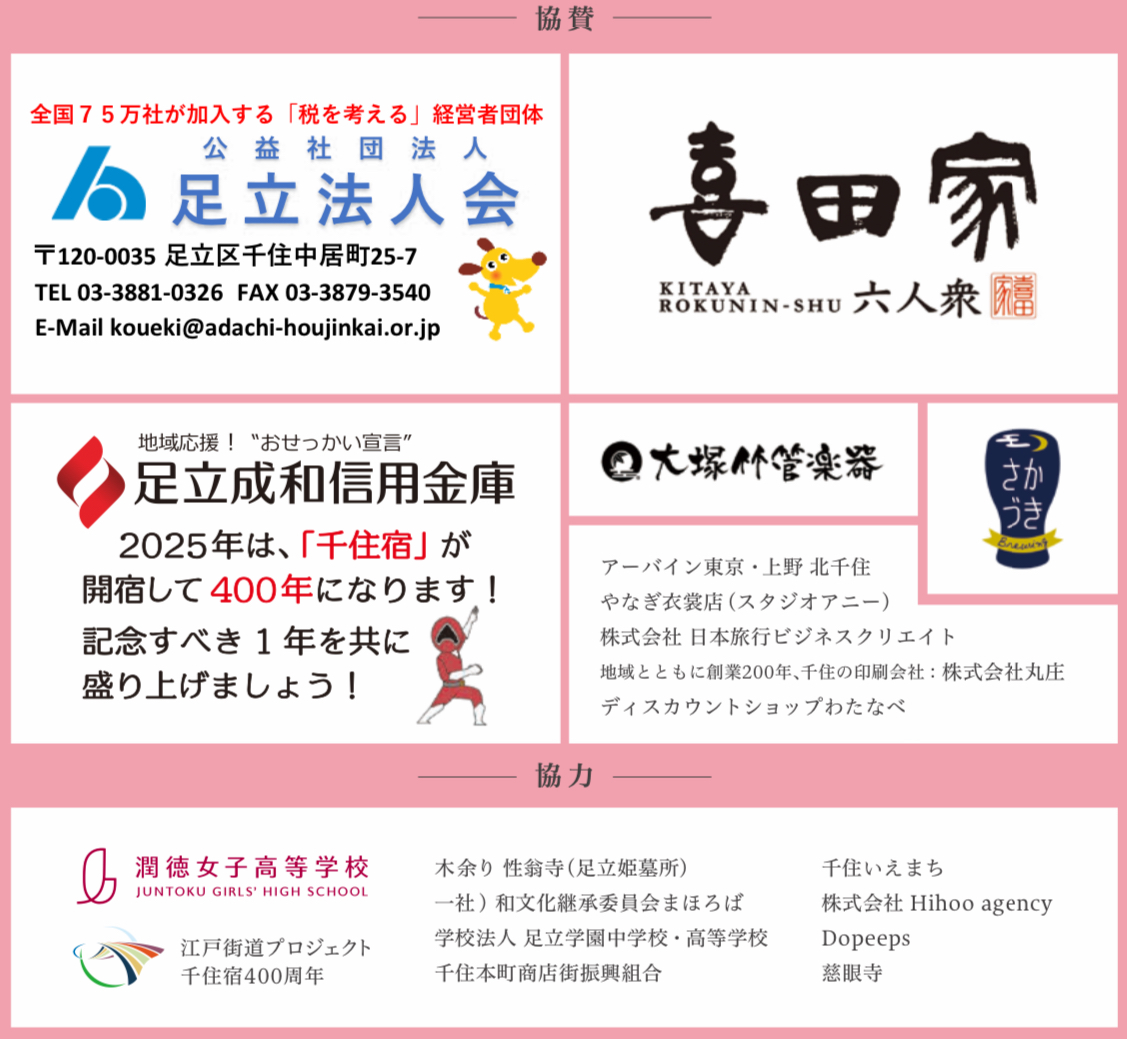
夕べ、今年お初の虫の音。
ジージジジ、コロコロロ。
デュオでした。
#女郎花
#オミナエシ
#秋の七草
#足立姫
#喜田屋
#ご馳走になりました❣️
#一花一服
#山野草
#山野草が好き
#アトリエ千花舎
#japanesewildflower

夕べ、今年お初の虫の音。
ジージジジ、コロコロロ。
デュオでした。
#女郎花
#オミナエシ
#秋の七草
#足立姫
#喜田屋
#ご馳走になりました❣️
#一花一服
#山野草
#山野草が好き
#アトリエ千花舎
#japanesewildflower
💐七月のお盆💐
東京では今日7月13日(日)からお盆が始まりました。
7月15日(火)がお盆当日です。13日を迎え、16日を送り、と言います。
お盆にはお墓参りをして亡き家族やご先祖をおうちにお迎えし、感謝をもってご供養しましょう。
#お盆 #お墓参り
#木余り #性翁寺
#足立姫 #江戸六阿弥陀巡り

💐七月のお盆💐
東京では今日7月13日(日)からお盆が始まりました。
7月15日(火)がお盆当日です。13日を迎え、16日を送り、と言います。
お盆にはお墓参りをして亡き家族やご先祖をおうちにお迎えし、感謝をもってご供養しましょう。
#お盆 #お墓参り
#木余り #性翁寺
#足立姫 #江戸六阿弥陀巡り
喜田家では、ワクワク集めて楽しい
初夏のとくとくキャンペーンを
開催しています。
6/1より配布スタートしています。
なくなり次第配布終了
喜田家店舗にて
1,000円(税込)お買上げ毎に
「猫の小判」を1枚プレゼント!!
小判10枚集めると
「足立姫5ケ入」と交換できます。
今だけ期間限定の機会お見逃しなく!!
足立姫とは…桜の花びらをいつも
楽しめたらの企画で作りました
やさしいお菓子。
花びらのような柔らかな羽二重餅に
京都の白味噌を使った柚子味噌餡を
しのばせてあります。
===================
千住宿喜田家ソラマチ店
℡03-5809-7185
お問い合わせはこちら
kitaya_rokuninshu
====================
#喜田家
#キャンペーン
#猫
#小判
#足立姫
#プレセント
#和菓子
#tokyo-solamachi
#和菓子屋
#和菓子好き
#和菓子職人
#和菓子好きな人と繋がりたい
#wagashi
#japanesesweets

喜田家では、ワクワク集めて楽しい
初夏のとくとくキャンペーンを
開催しています。
6/1より配布スタートしています。
なくなり次第配布終了
喜田家店舗にて
1,000円(税込)お買上げ毎に
「猫の小判」を1枚プレゼント!!
小判10枚集めると
「足立姫5ケ入」と交換できます。
今だけ期間限定の機会お見逃しなく!!
足立姫とは…桜の花びらをいつも
楽しめたらの企画で作りました
やさしいお菓子。
花びらのような柔らかな羽二重餅に
京都の白味噌を使った柚子味噌餡を
しのばせてあります。
===================
千住宿喜田家ソラマチ店
℡03-5809-7185
お問い合わせはこちら
kitaya_rokuninshu
====================
#喜田家
#キャンペーン
#猫
#小判
#足立姫
#プレセント
#和菓子
#tokyo-solamachi
#和菓子屋
#和菓子好き
#和菓子職人
#和菓子好きな人と繋がりたい
#wagashi
#japanesesweets
・
・
#今日のおやつ
・
先週から第九の初心者練習会に参加してまして。
再び浅草通いしてます🤭
・
浅草の松屋で購入した喜田家さんの「足立姫」
京都の白味噌を使った柚子味噌餡がやわらかい二重も餅にはさまってるの🥹
美味しくないわけがないっっ‼️
・
とってもお上品でうまうまでした😋
・
最近、和菓子にハマってます😆
・
#おやつ #喜田家 #足立姫
#読書のお供 #なかなか読み終わらない

・
・
#今日のおやつ
・
先週から第九の初心者練習会に参加してまして。
再び浅草通いしてます🤭
・
浅草の松屋で購入した喜田家さんの「足立姫」
京都の白味噌を使った柚子味噌餡がやわらかい二重も餅にはさまってるの🥹
美味しくないわけがないっっ‼️
・
とってもお上品でうまうまでした😋
・
最近、和菓子にハマってます😆
・
#おやつ #喜田家 #足立姫
#読書のお供 #なかなか読み終わらない
いつもご利用いただきまして、ありがとうございます。
このたび、喜田家では「初夏のとくとくキャンペーン」を開催いたします!
配布開始日2025年6月1日(日)より
★無くなり次第配布終了
🍀キャンペーン内容🍀
税込1000円お買い上げごとに「猫の小判」1枚を差し上げます。
小判を10枚集めていただくと、「足立姫5個入)」と交換いたします。
ぜひこの機会に、楽しいお買い物をお楽しみくださいませ。
*********************
【喜田家 五反野店】
📞03-3886-4266
住所:東京都足立区弘道1-1-2
営業時間⏰:9:00~18:00
(火曜日のみ 17:00まで)
東武スカイツリーライン 五反野駅より徒歩1分
*********************
#喜田家 #喜田家五反野 #和菓子 #日本文化
#和菓子好きな人と繋がりたい #足立区 #東京
#和スイーツ #足立姫 #千住 #千住宿開宿400年
#TokyoTravel
#TokyoSouvenir
#JapanSouvenir
#Omiyage
#JapaneseSweets
#Wagashi
#Dorayaki
#Manju
#MatchaSweets
#JapanFood
#Adachi
#Gotanno
#wagashi
#Gift
#Sweets

いつもご利用いただきまして、ありがとうございます。
このたび、喜田家では「初夏のとくとくキャンペーン」を開催いたします!
配布開始日2025年6月1日(日)より
★無くなり次第配布終了
🍀キャンペーン内容🍀
税込1000円お買い上げごとに「猫の小判」1枚を差し上げます。
小判を10枚集めていただくと、「足立姫5個入)」と交換いたします。
ぜひこの機会に、楽しいお買い物をお楽しみくださいませ。
*********************
【喜田家 五反野店】
📞03-3886-4266
住所:東京都足立区弘道1-1-2
営業時間⏰:9:00~18:00
(火曜日のみ 17:00まで)
東武スカイツリーライン 五反野駅より徒歩1分
*********************
#喜田家 #喜田家五反野 #和菓子 #日本文化
#和菓子好きな人と繋がりたい #足立区 #東京
#和スイーツ #足立姫 #千住 #千住宿開宿400年
#TokyoTravel
#TokyoSouvenir
#JapanSouvenir
#Omiyage
#JapaneseSweets
#Wagashi
#Dorayaki
#Manju
#MatchaSweets
#JapanFood
#Adachi
#Gotanno
#wagashi
#Gift
#Sweets